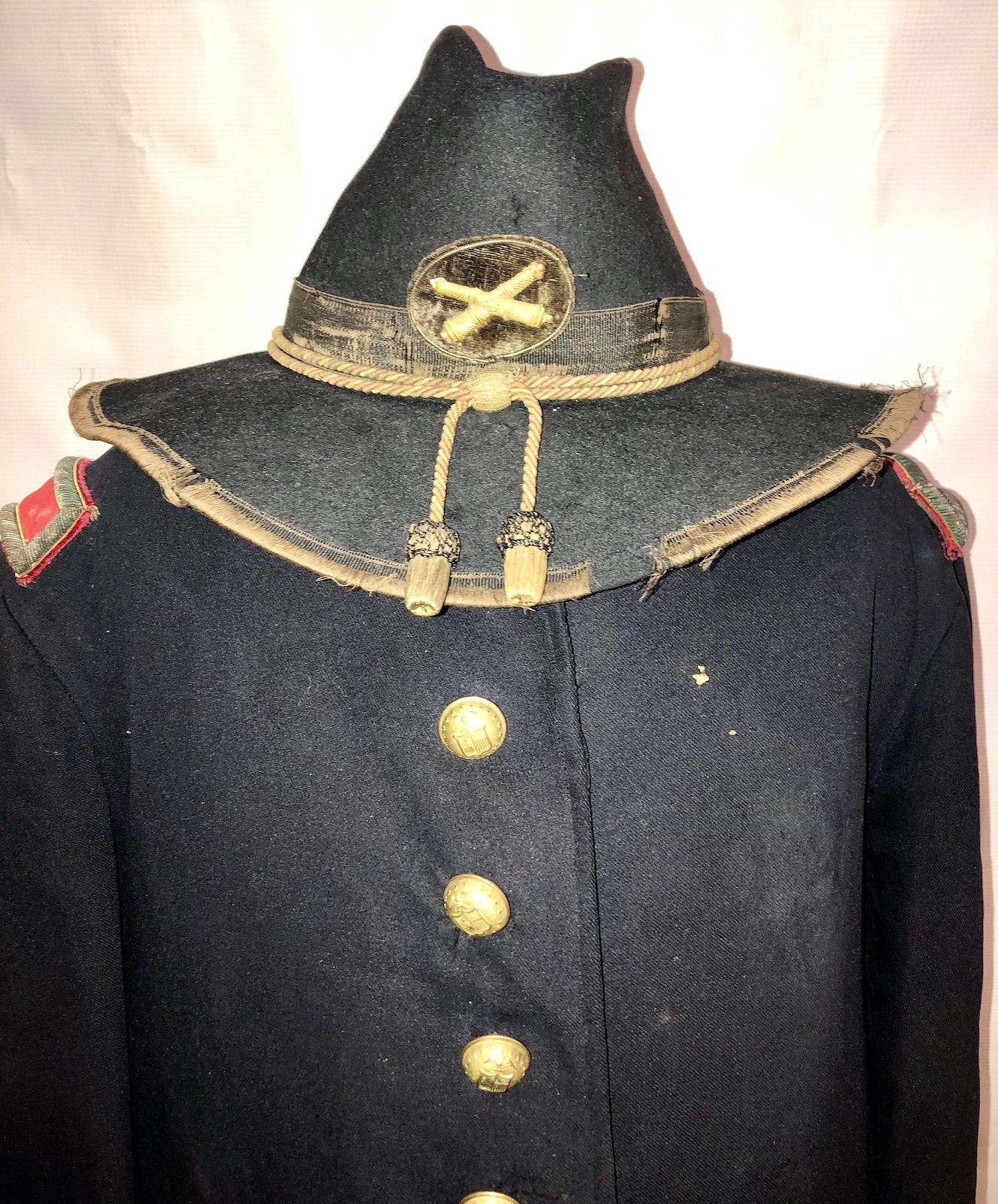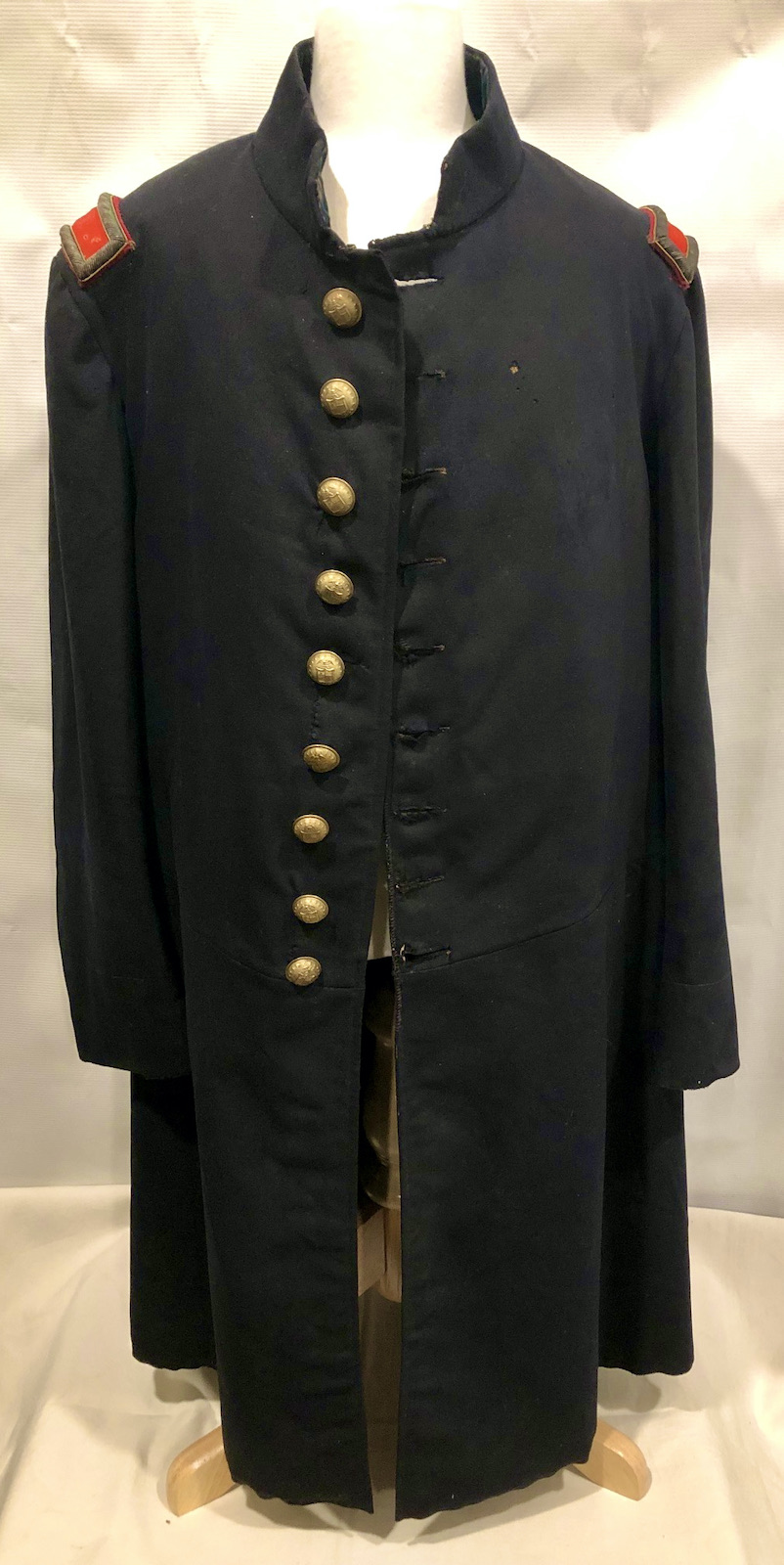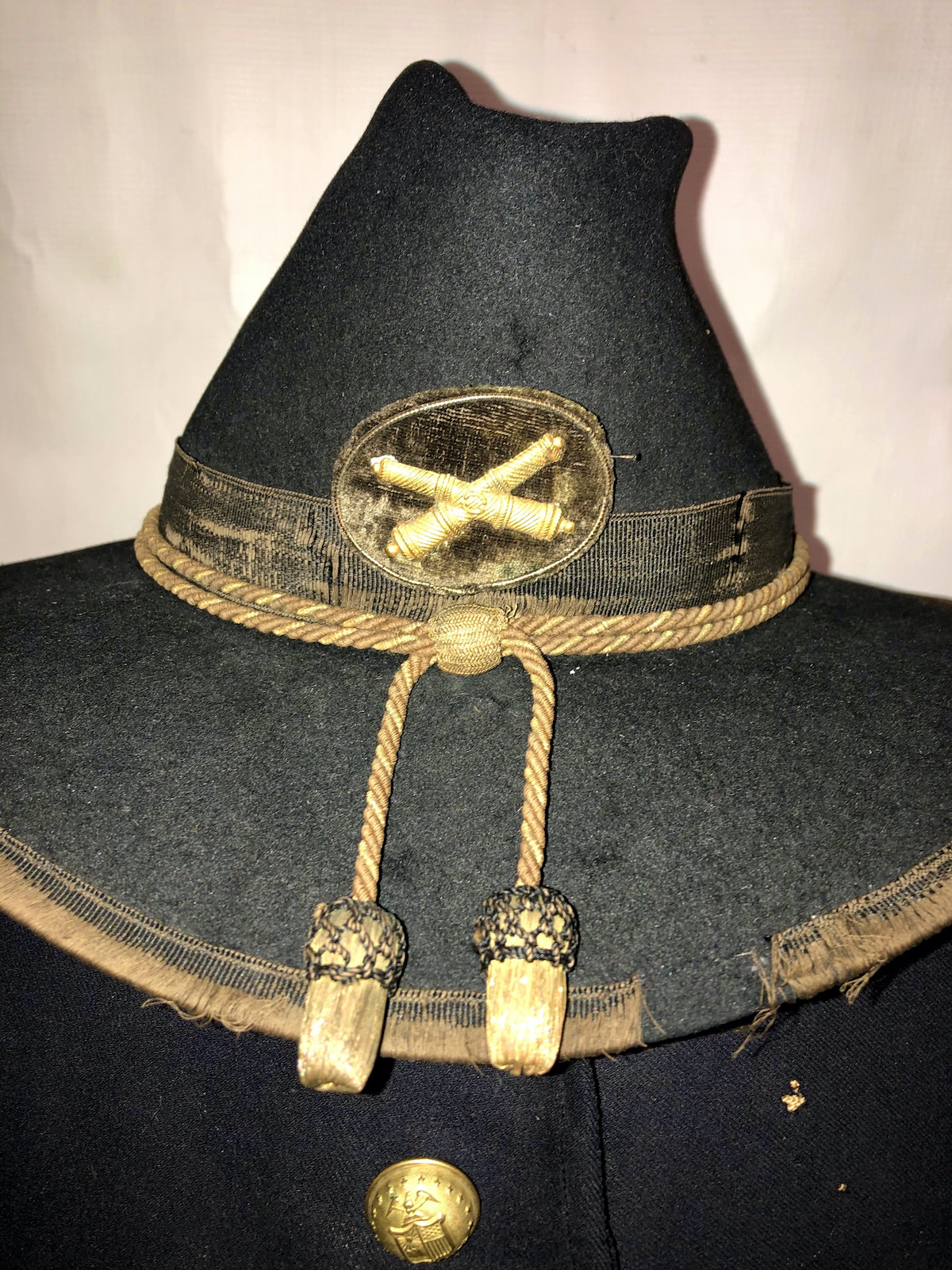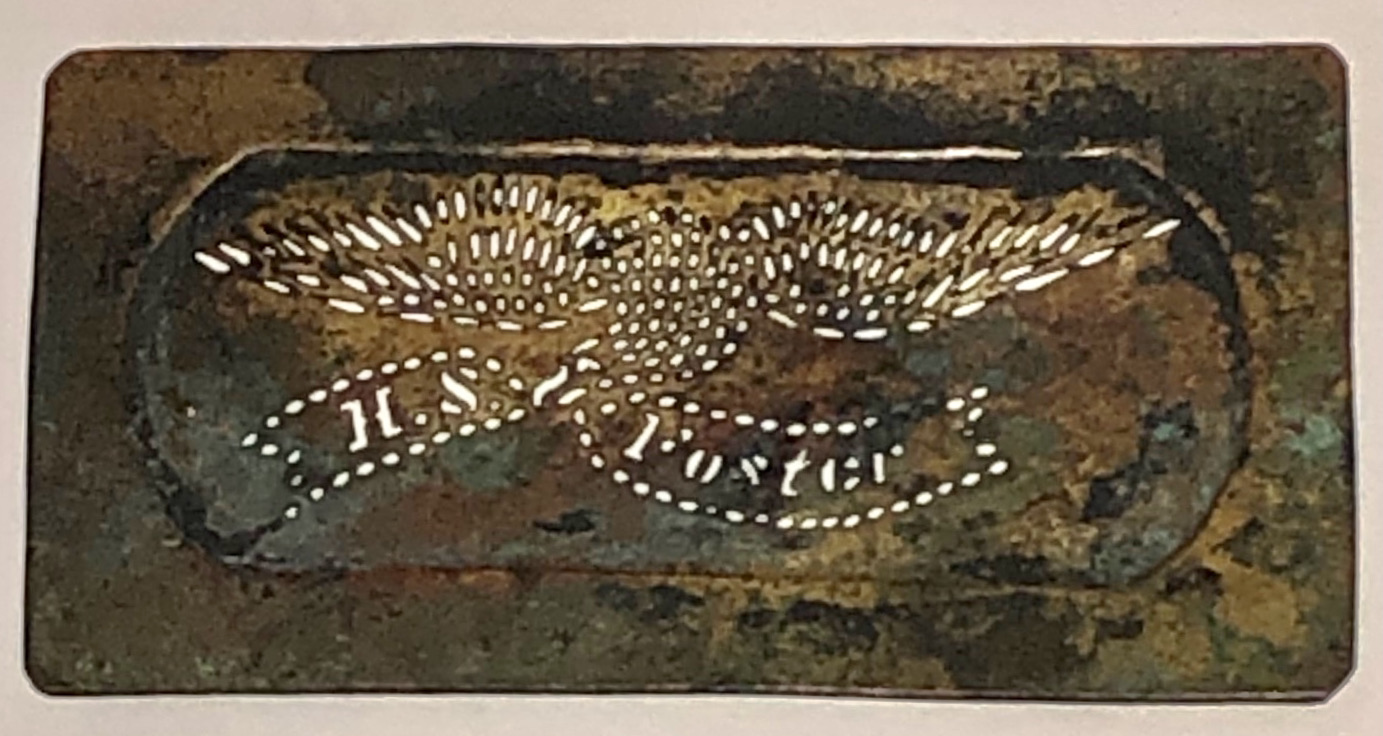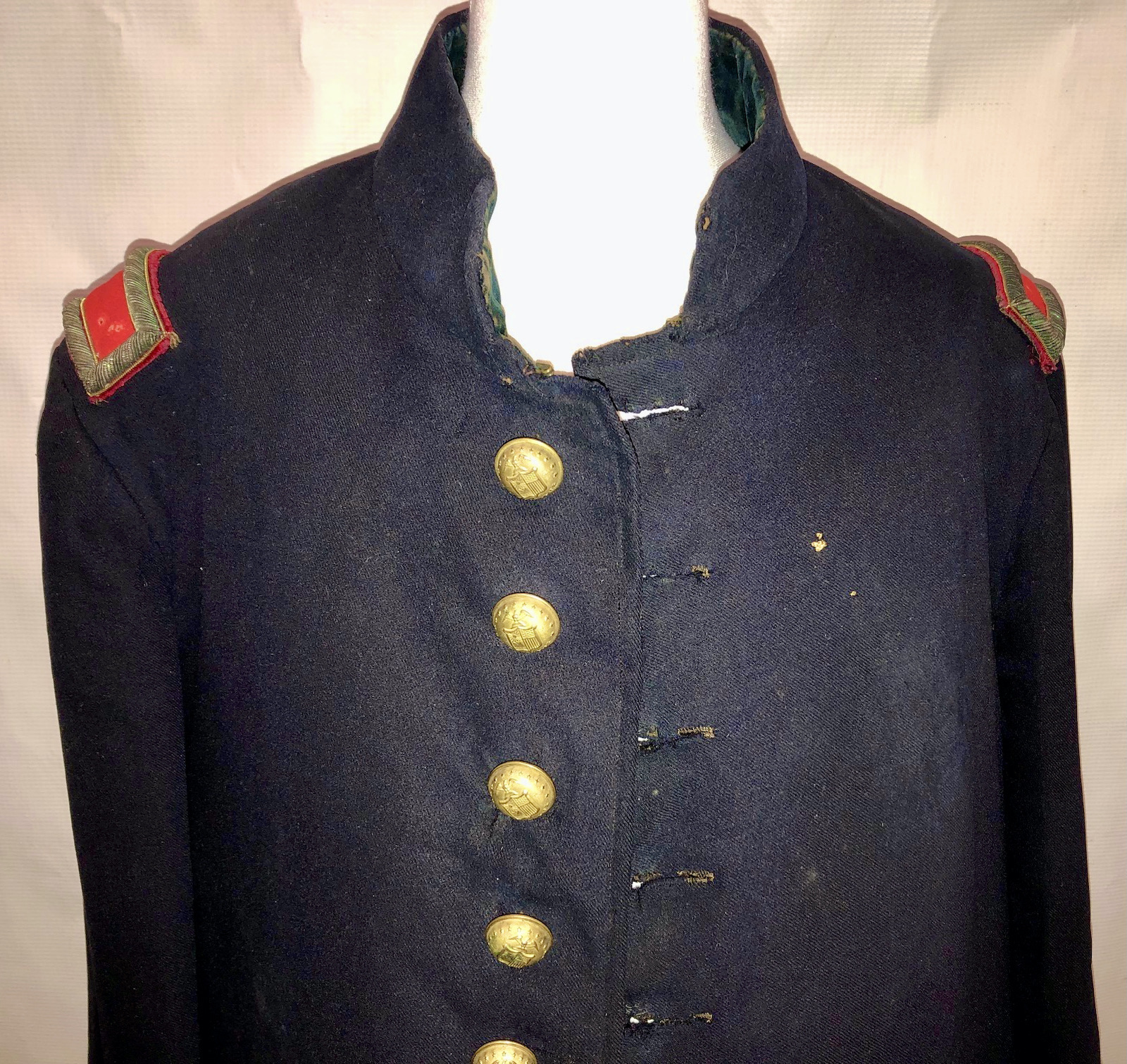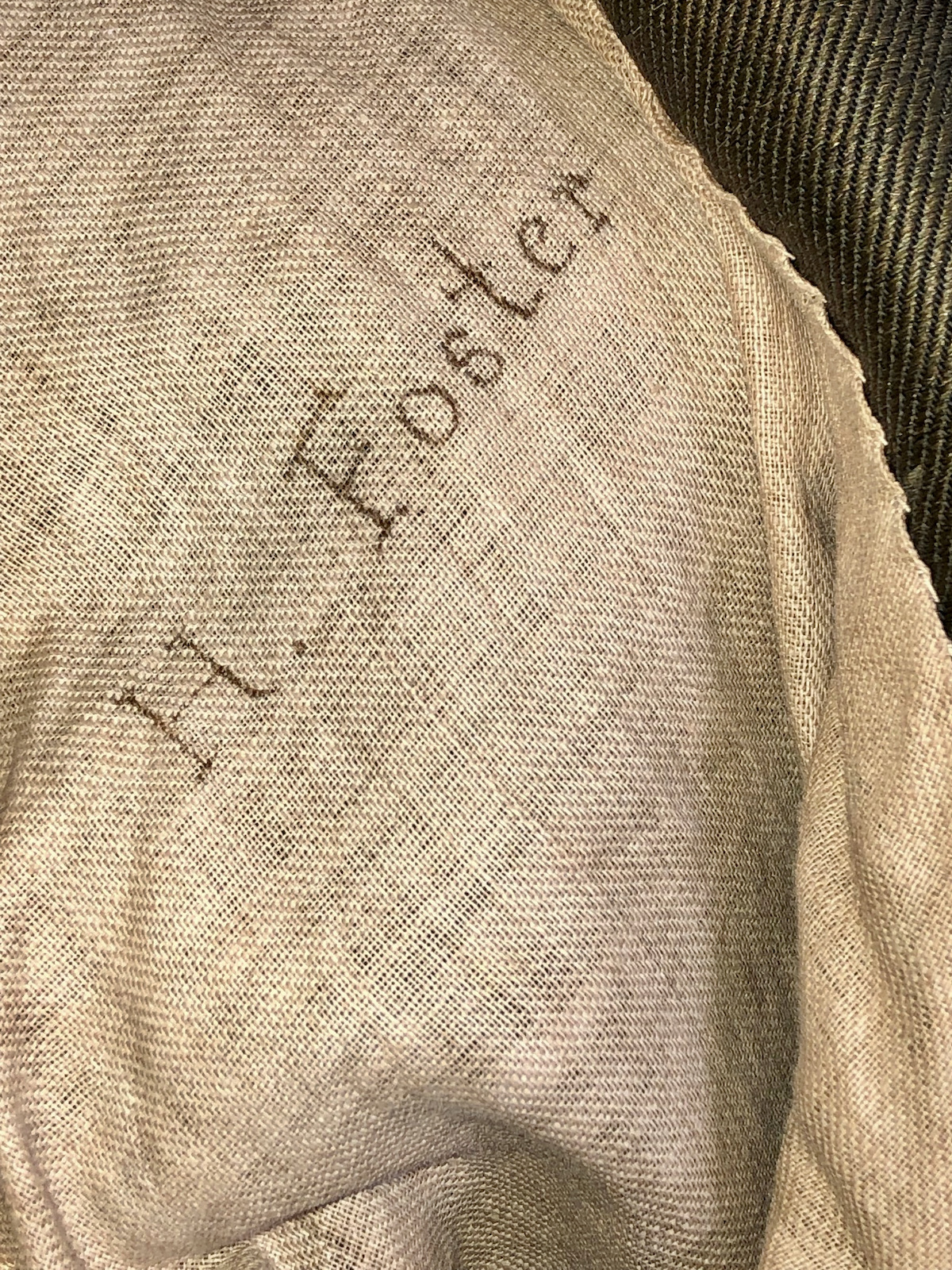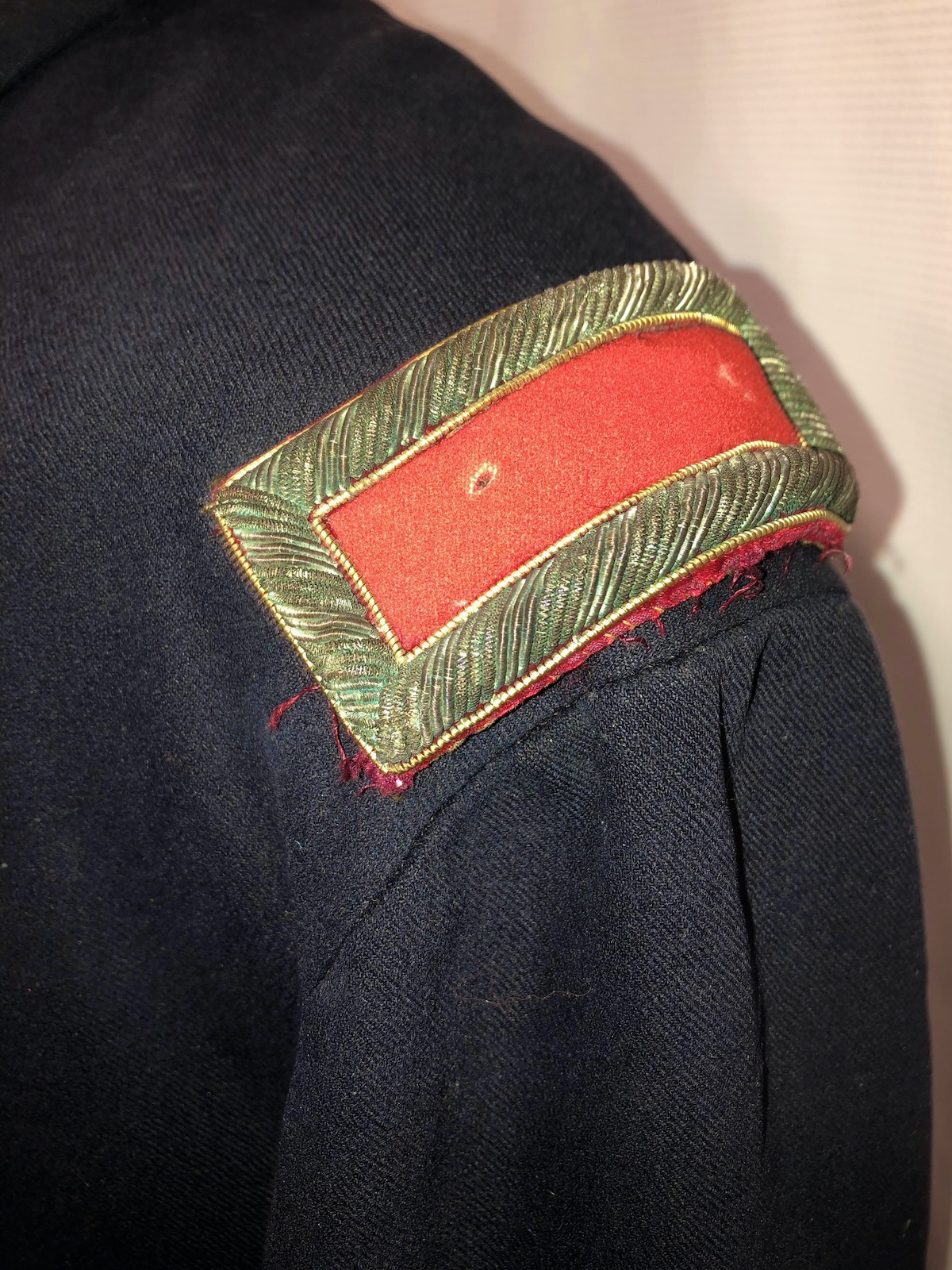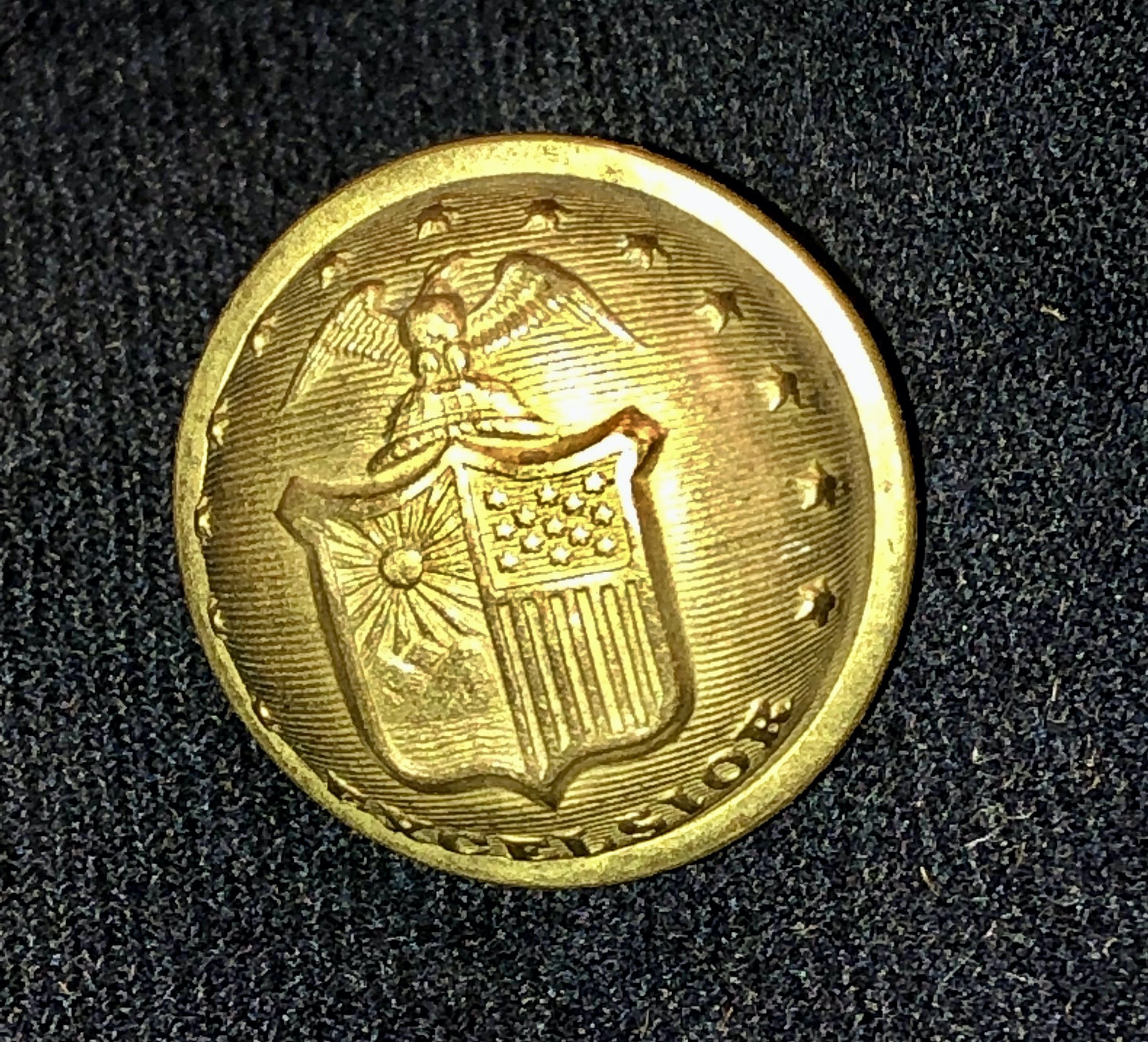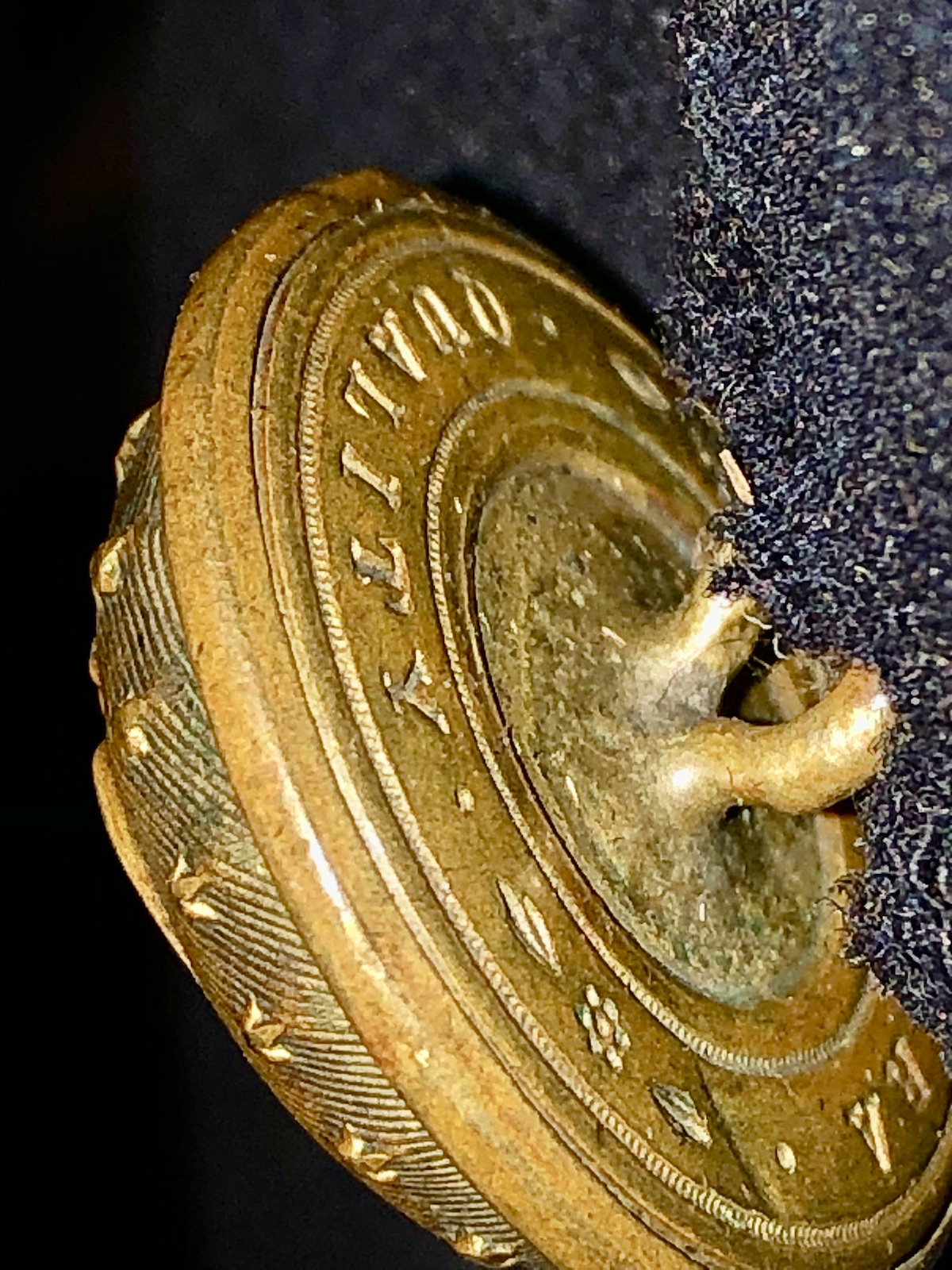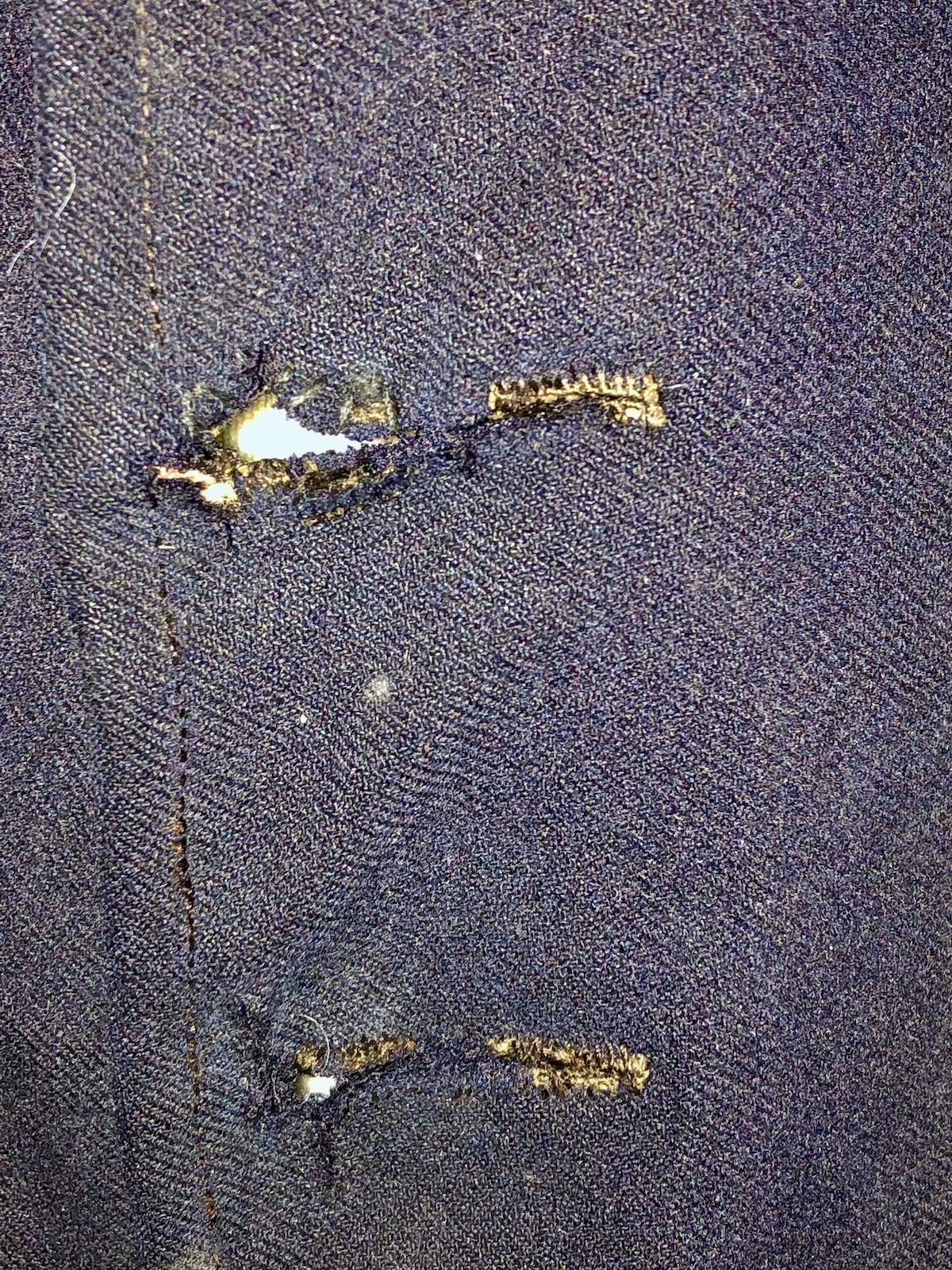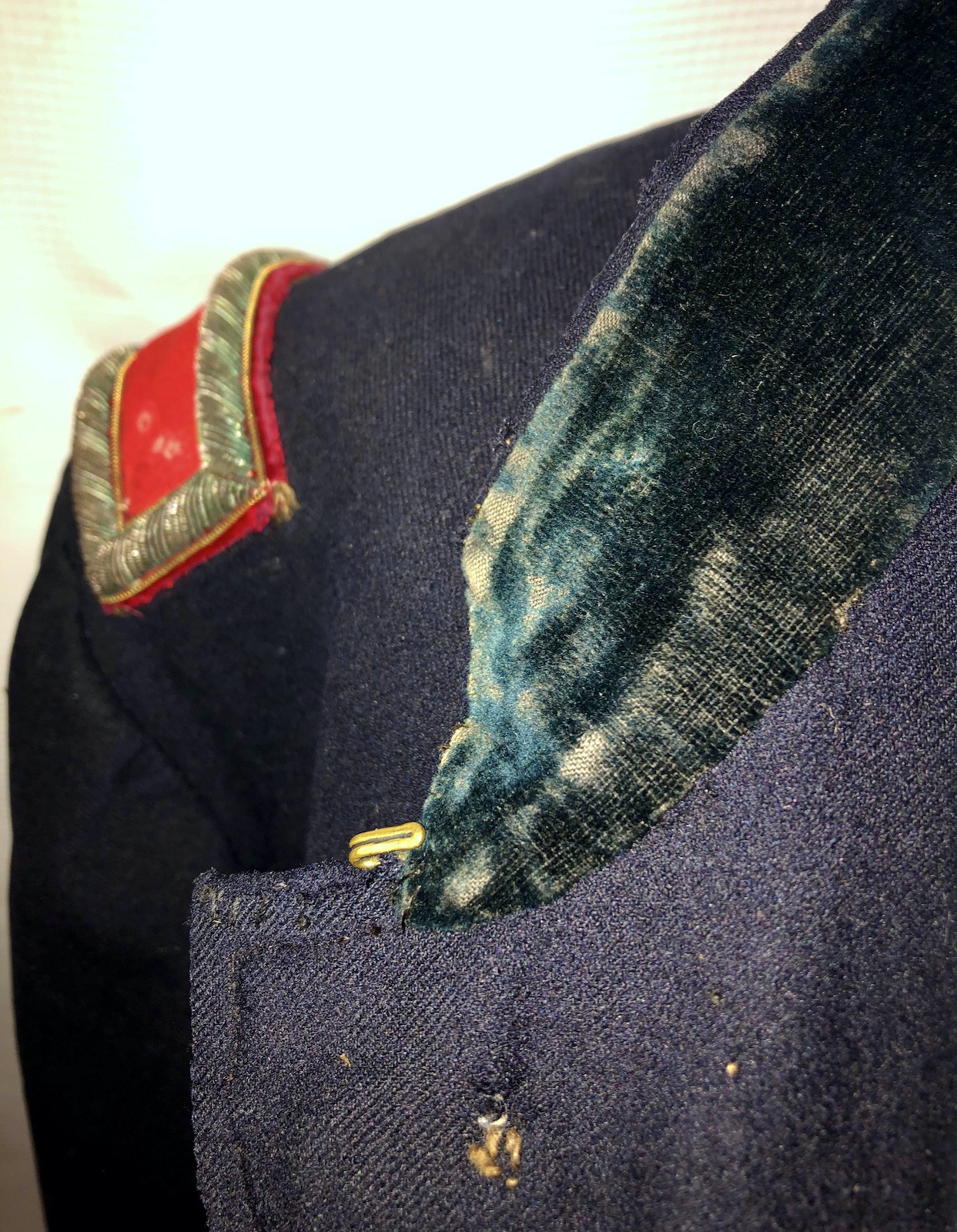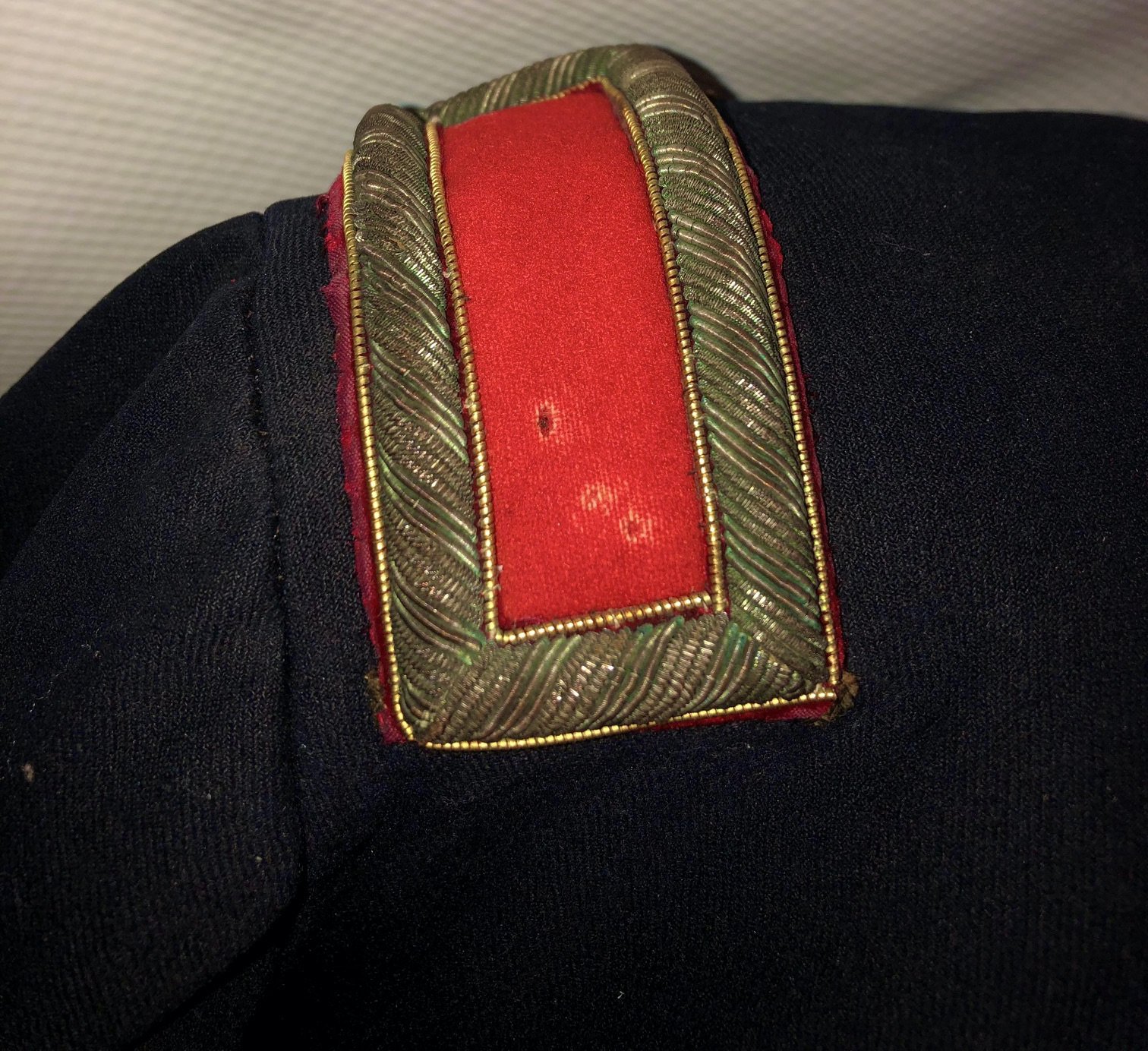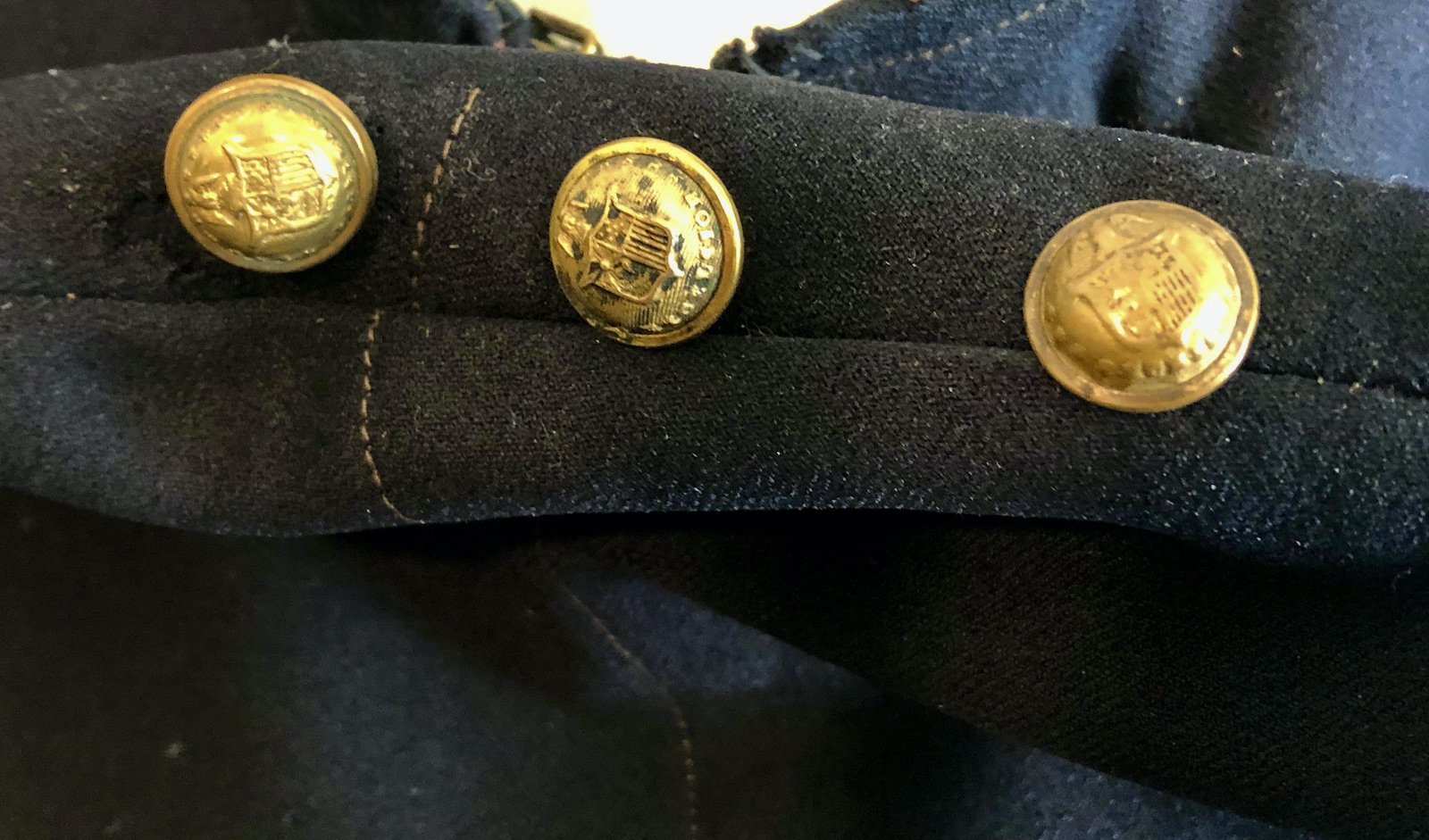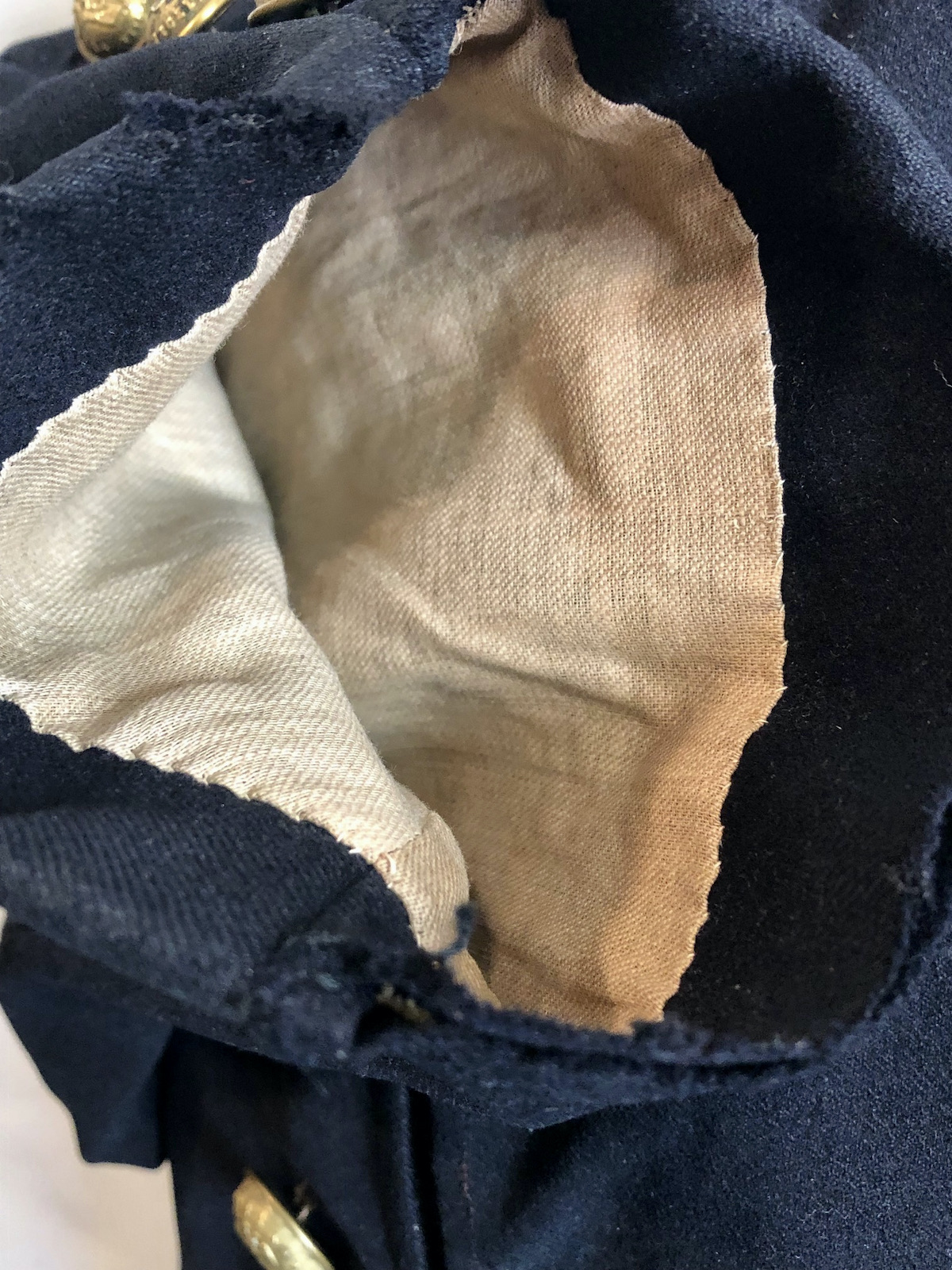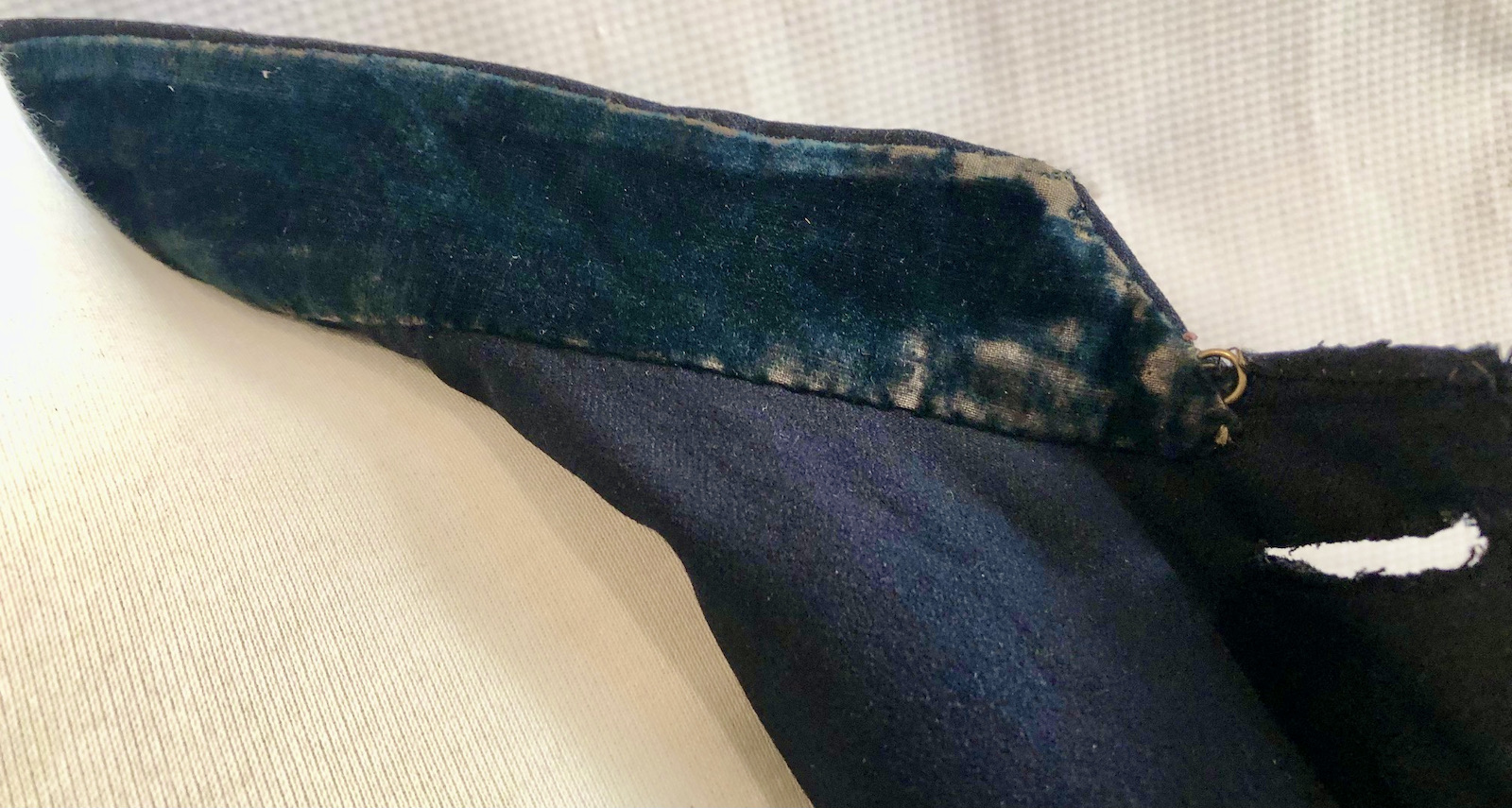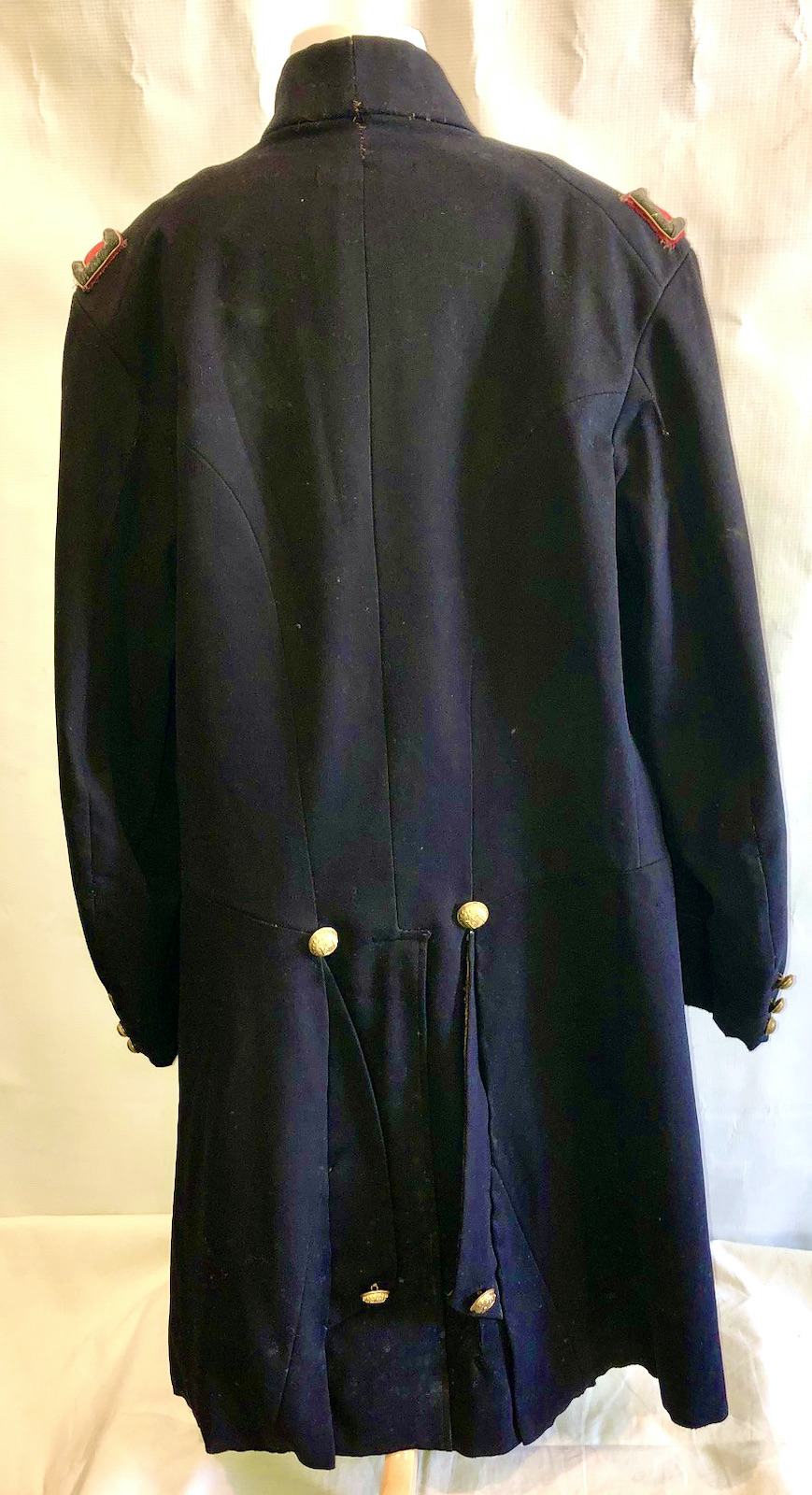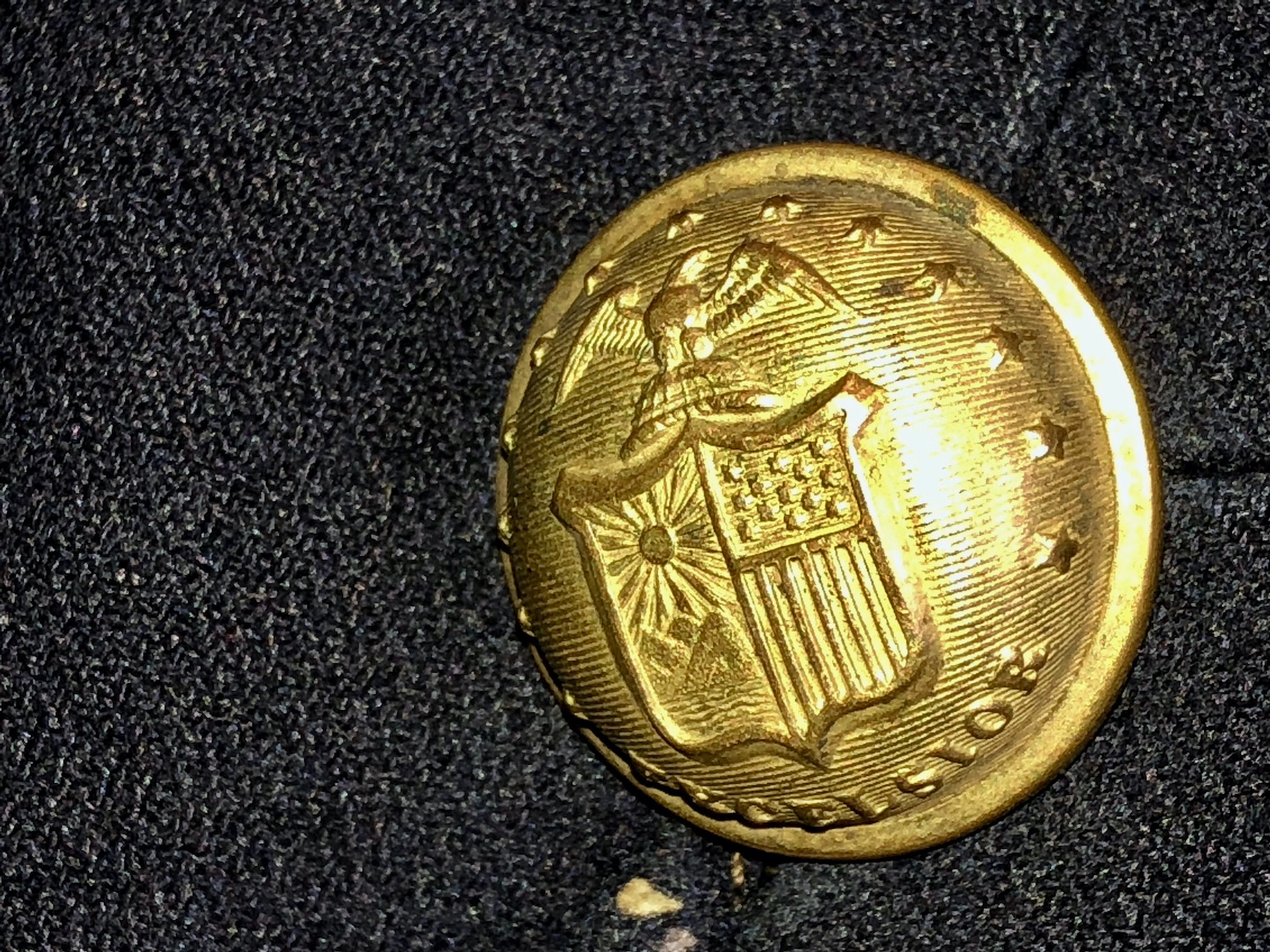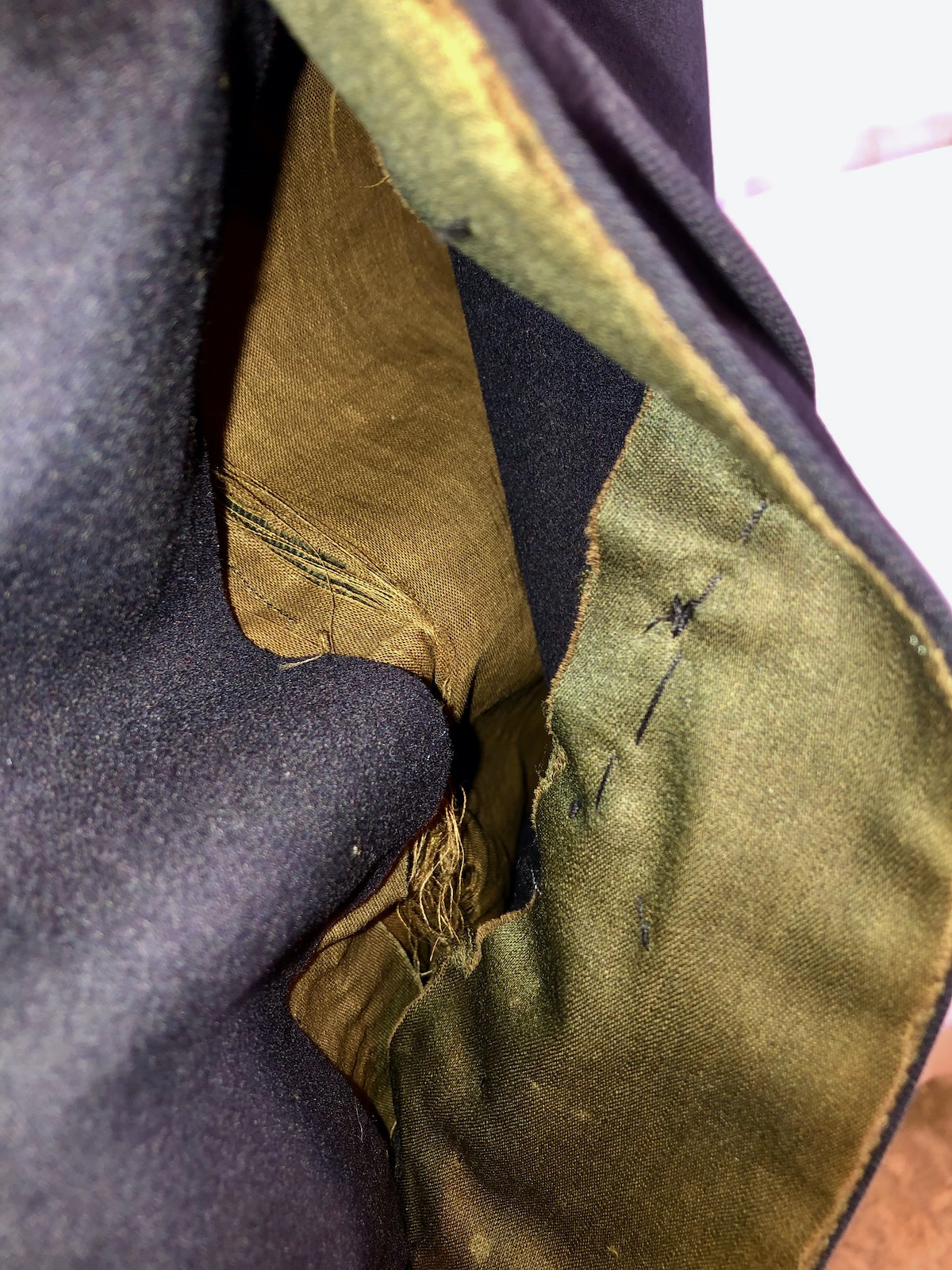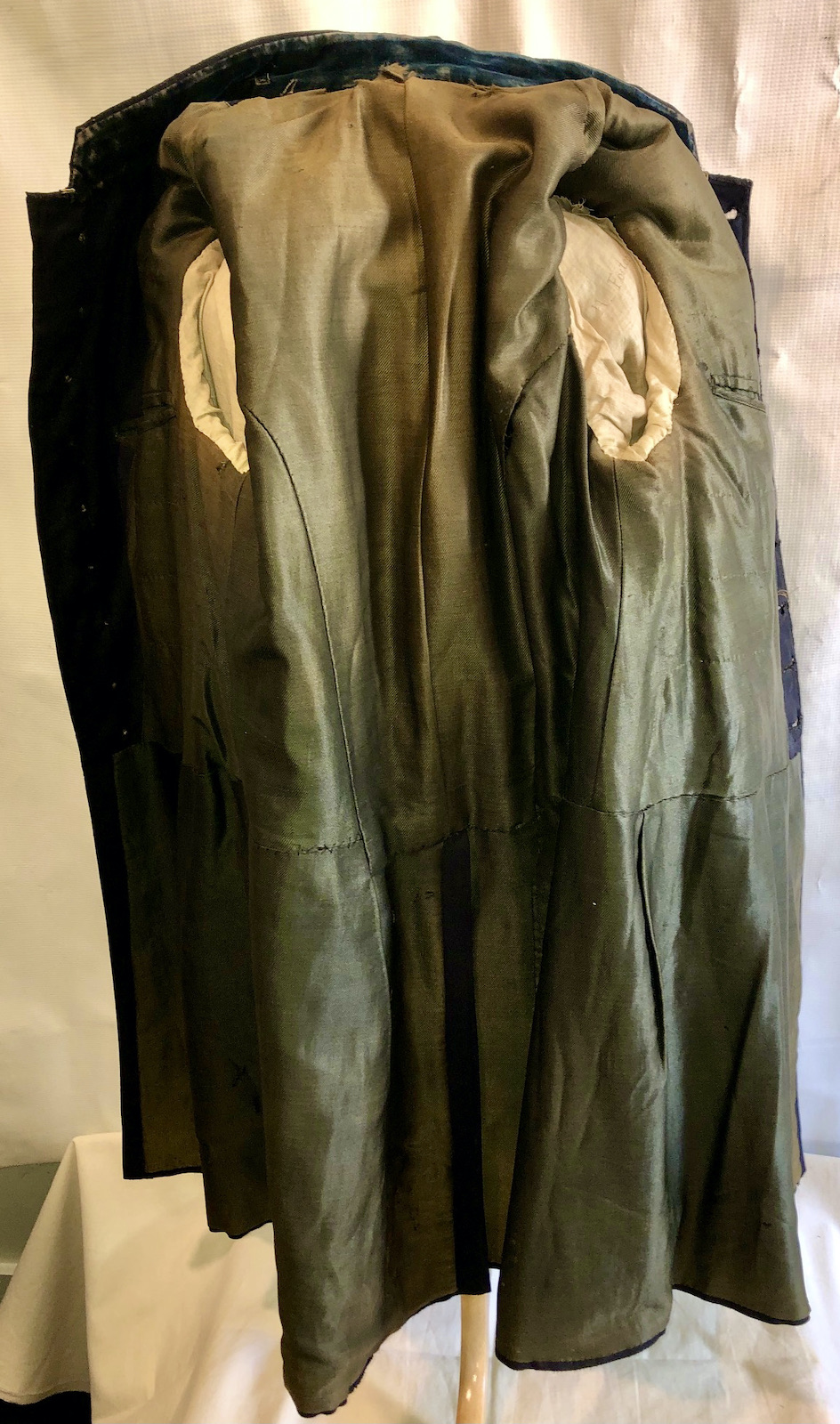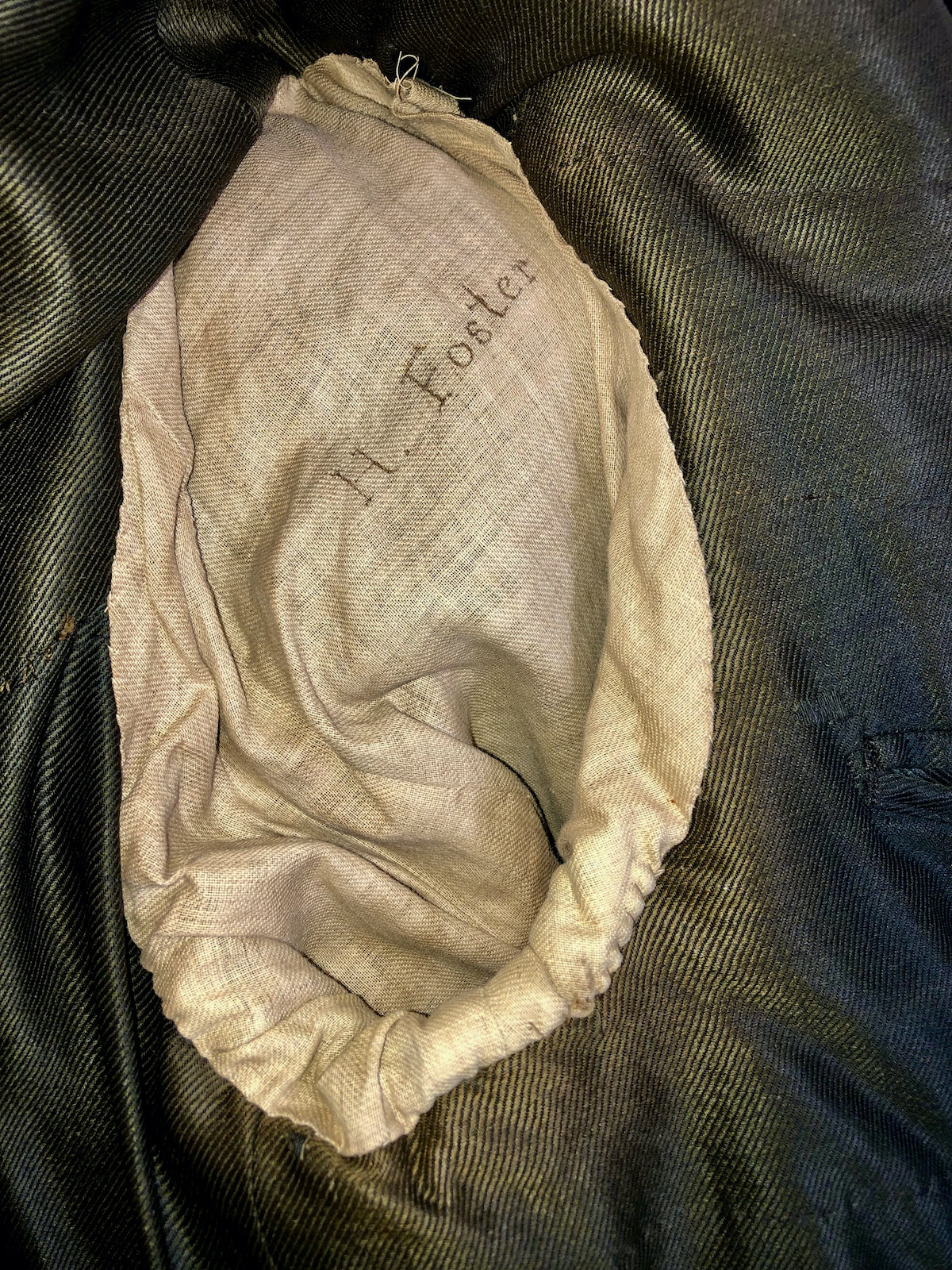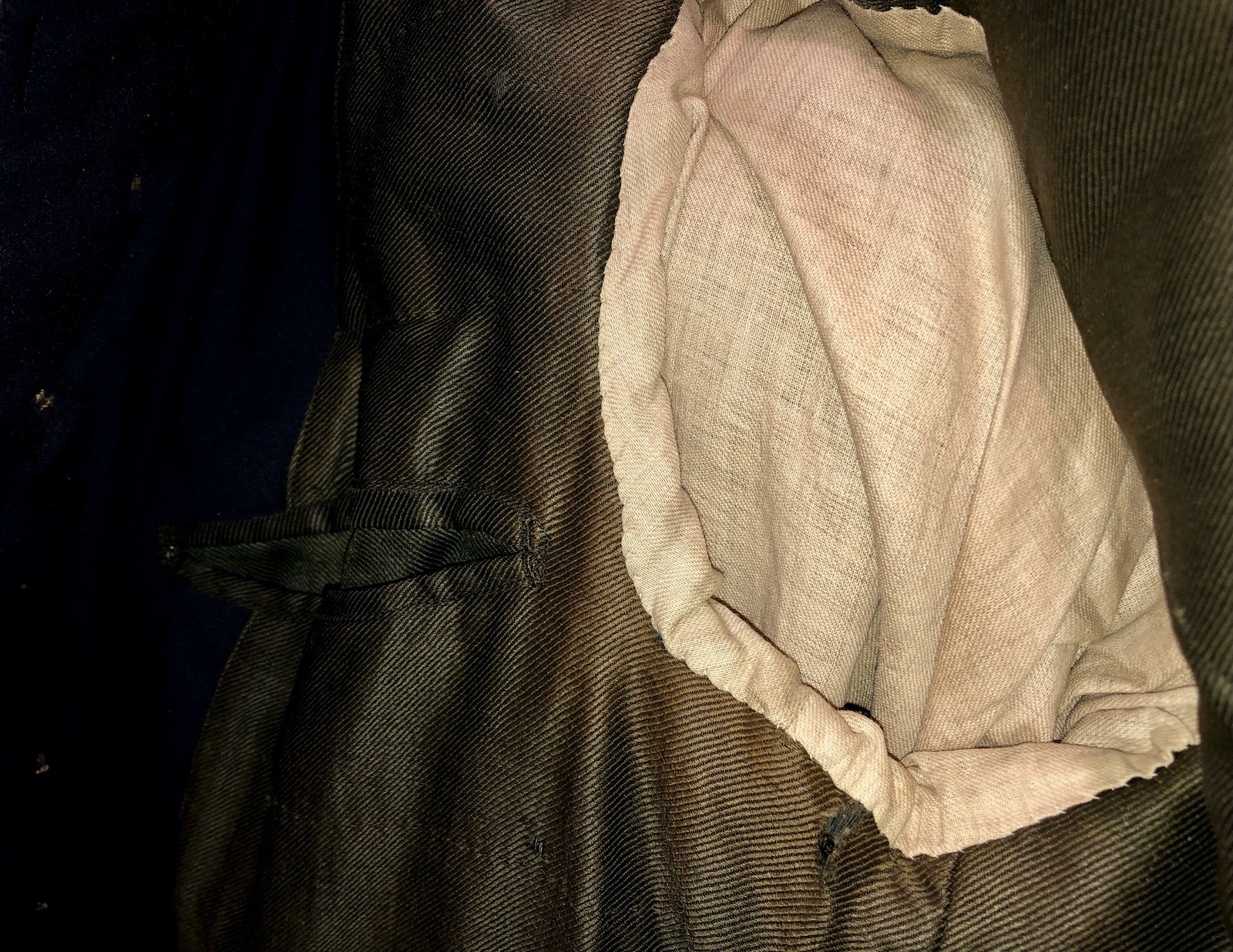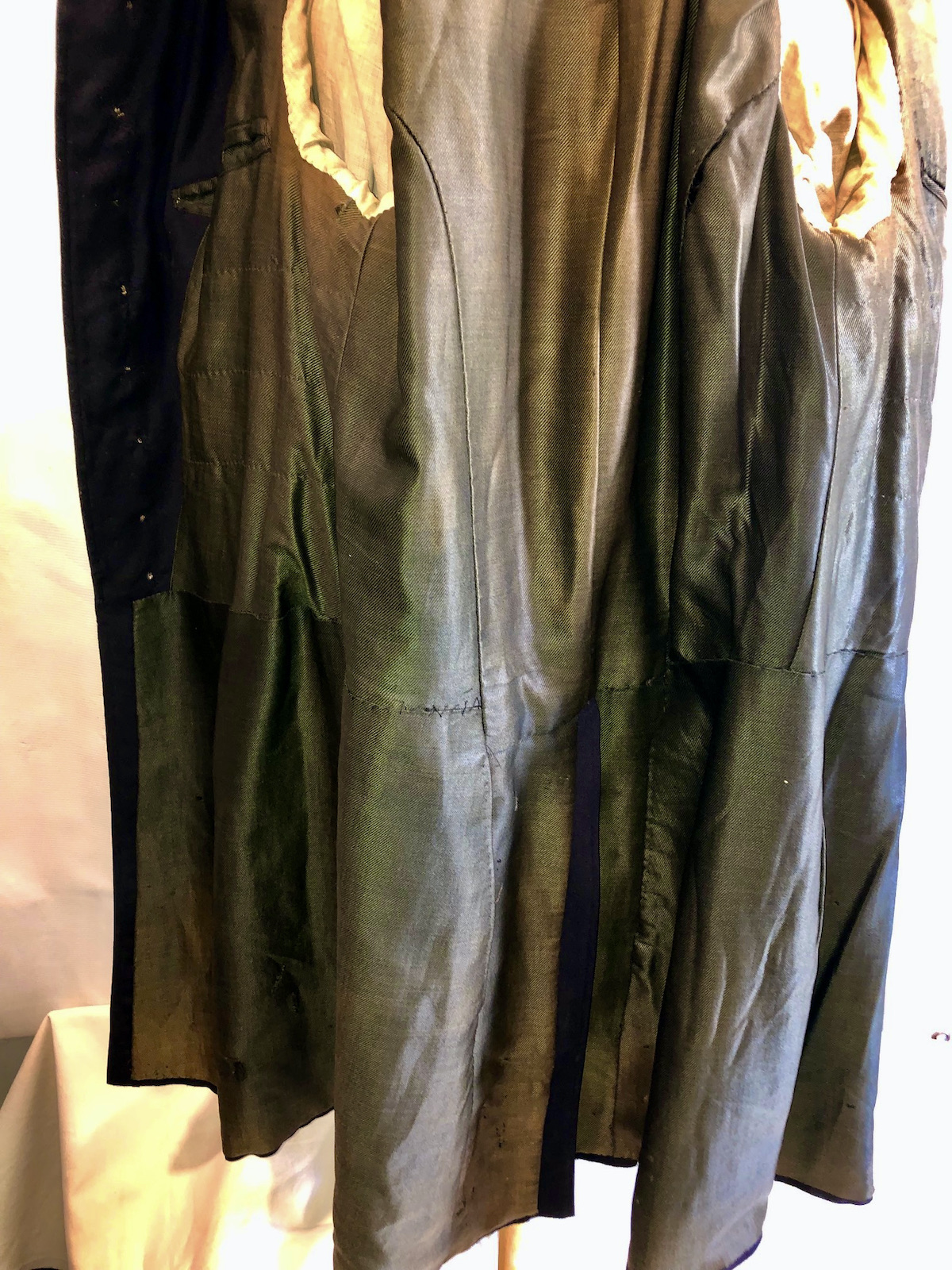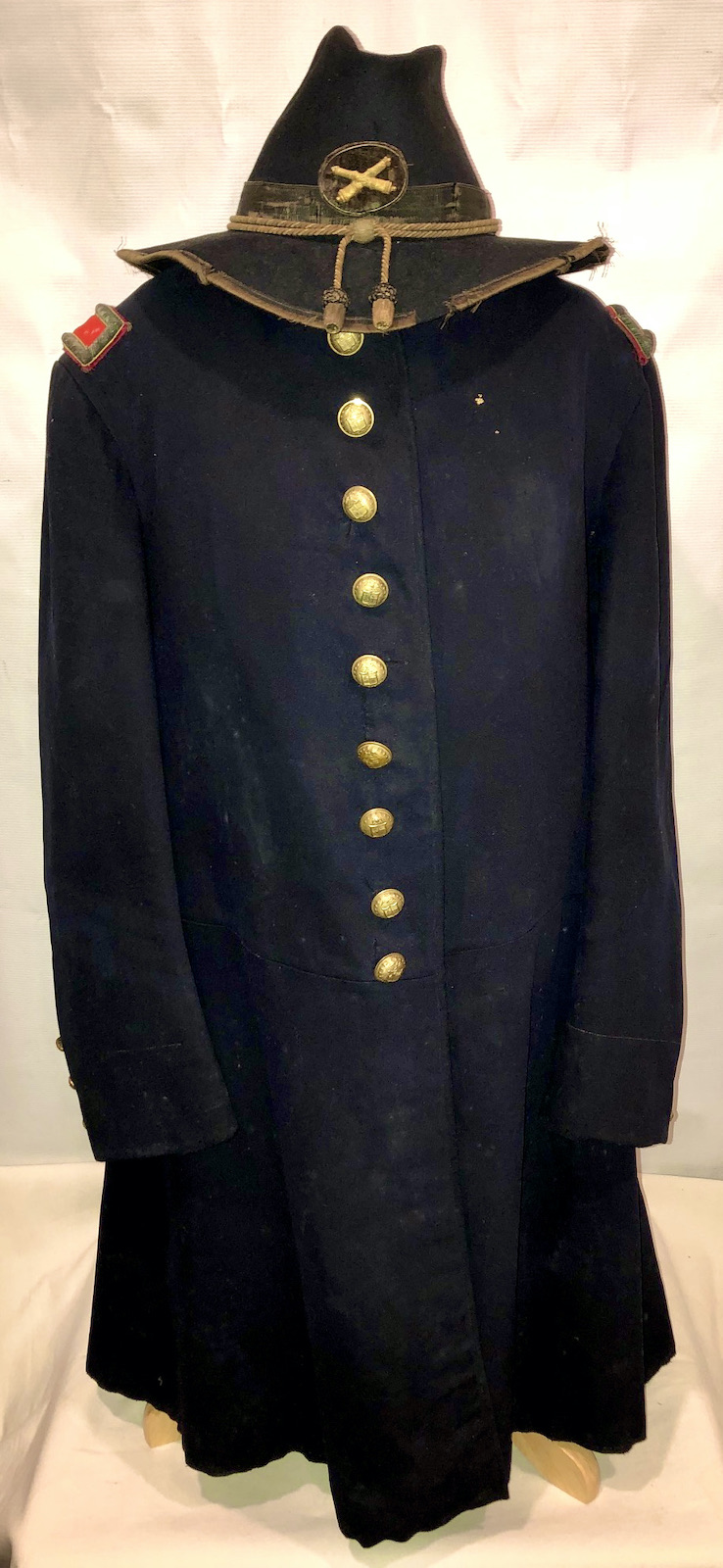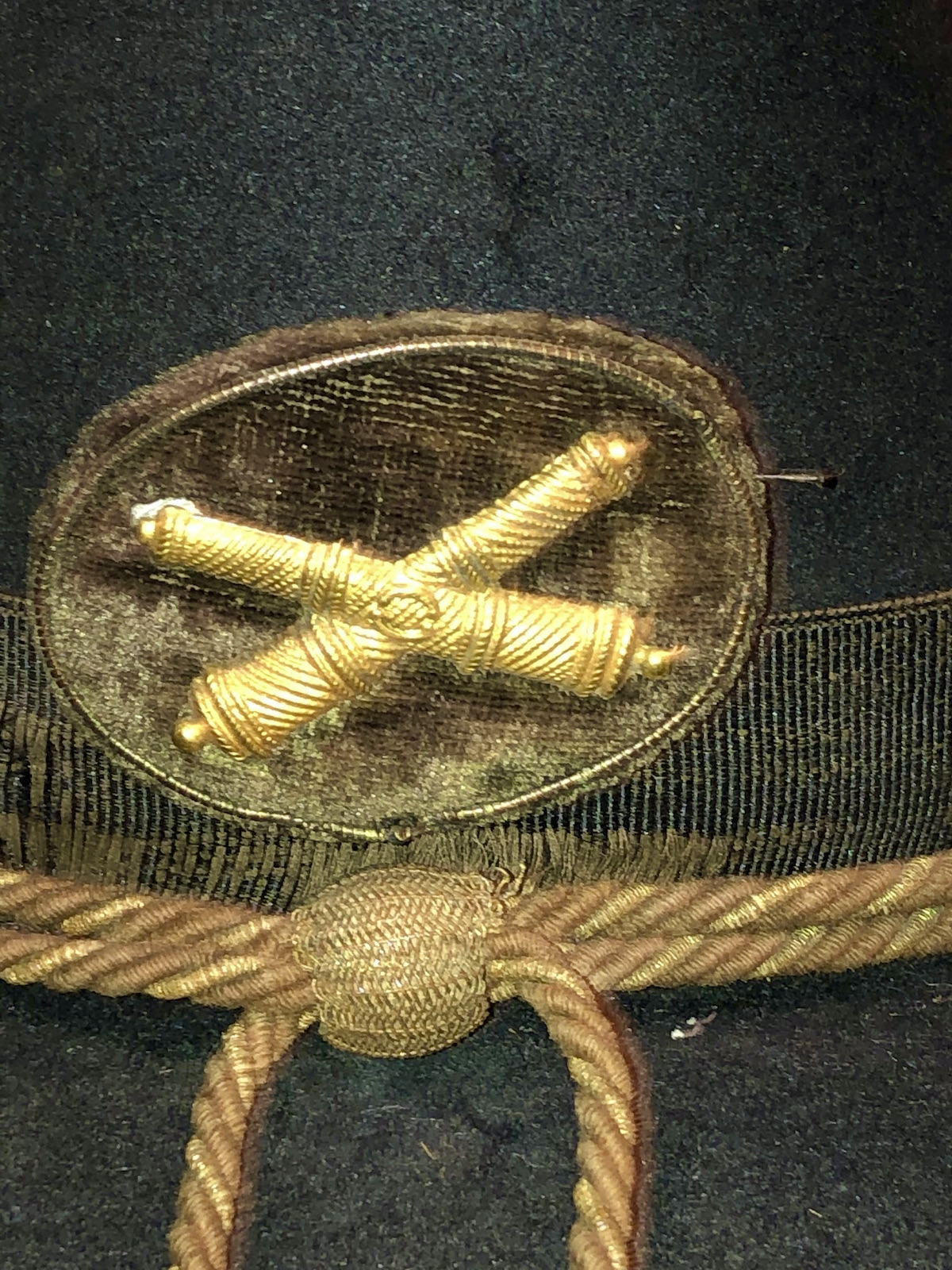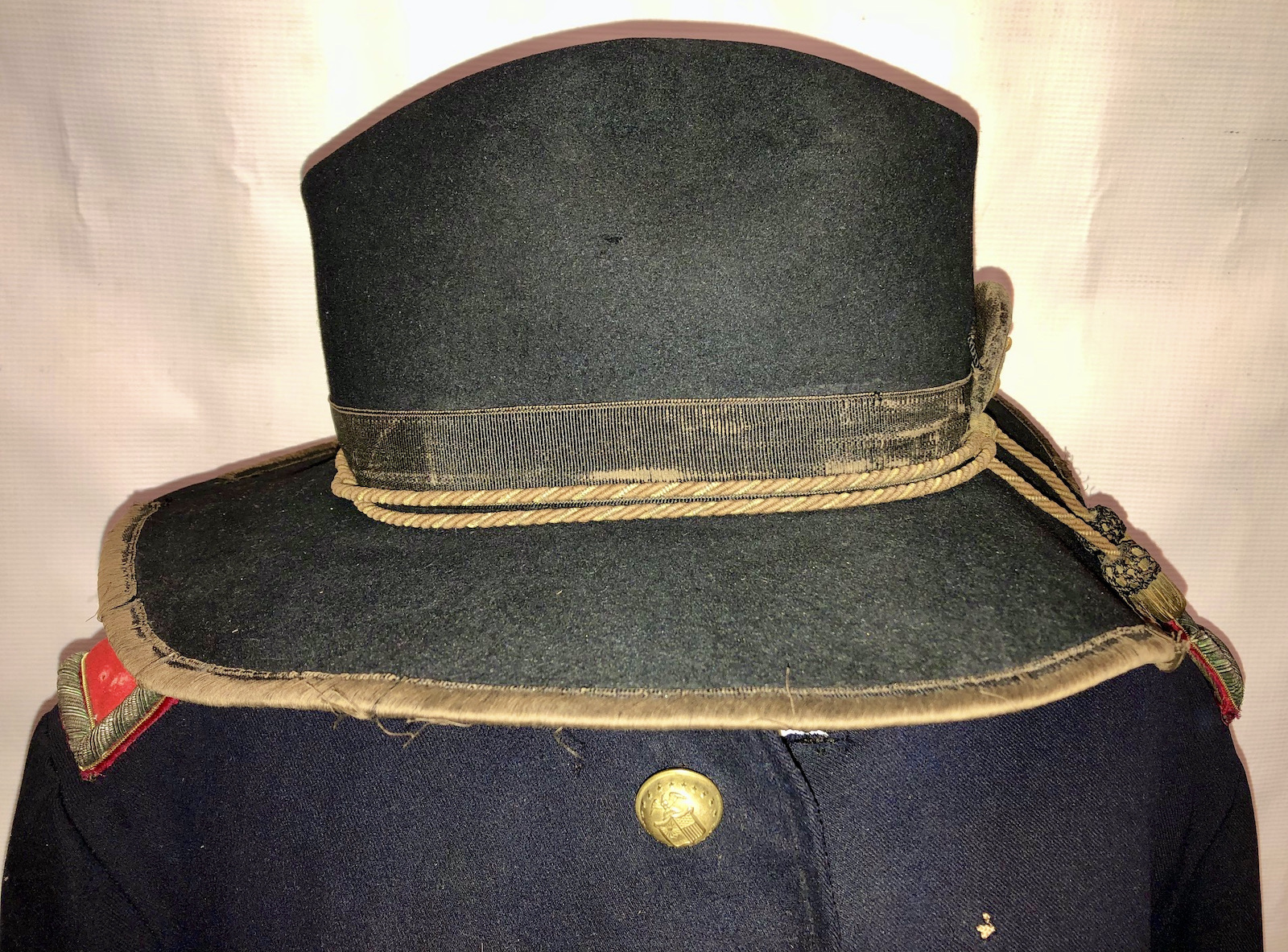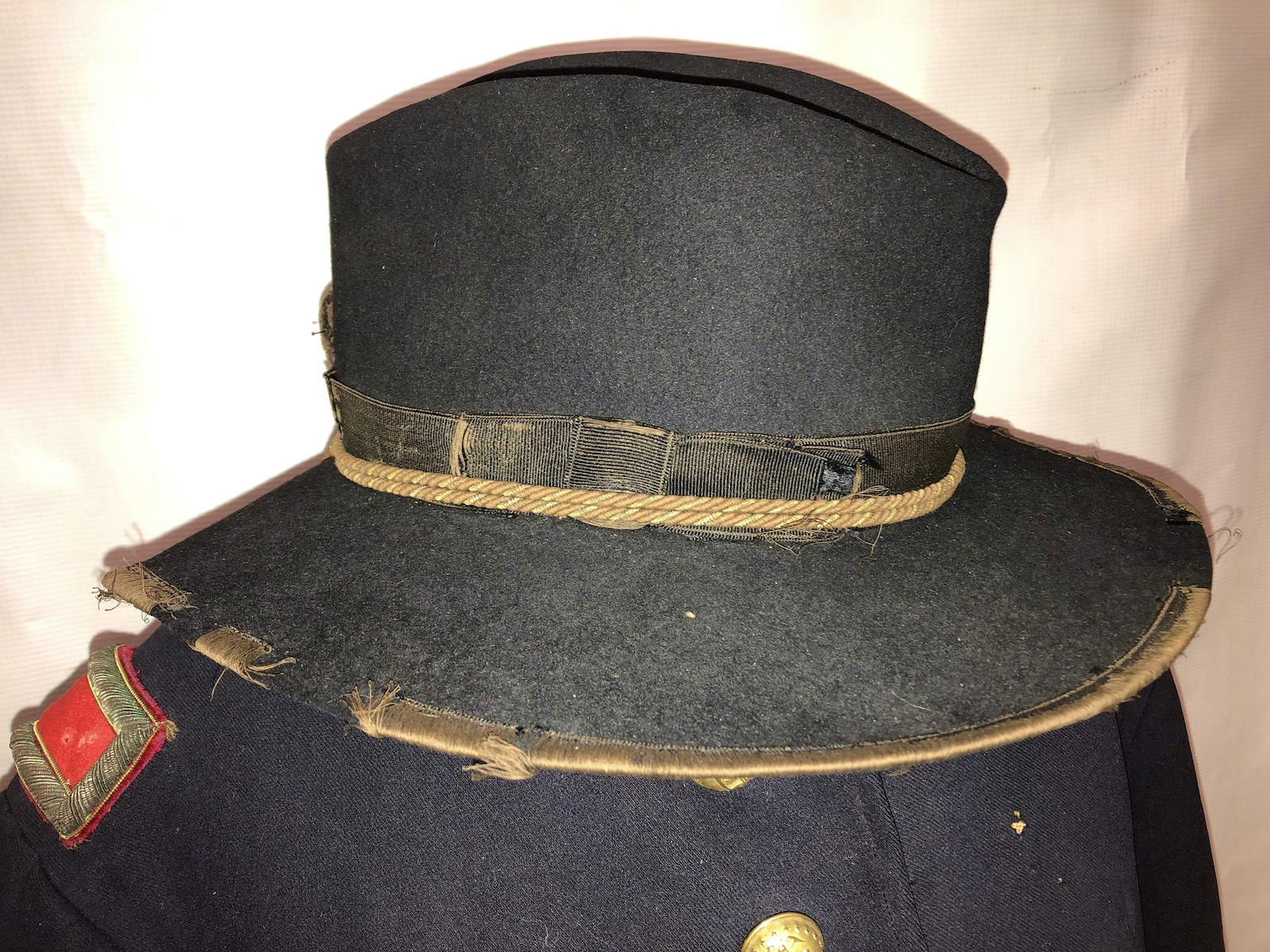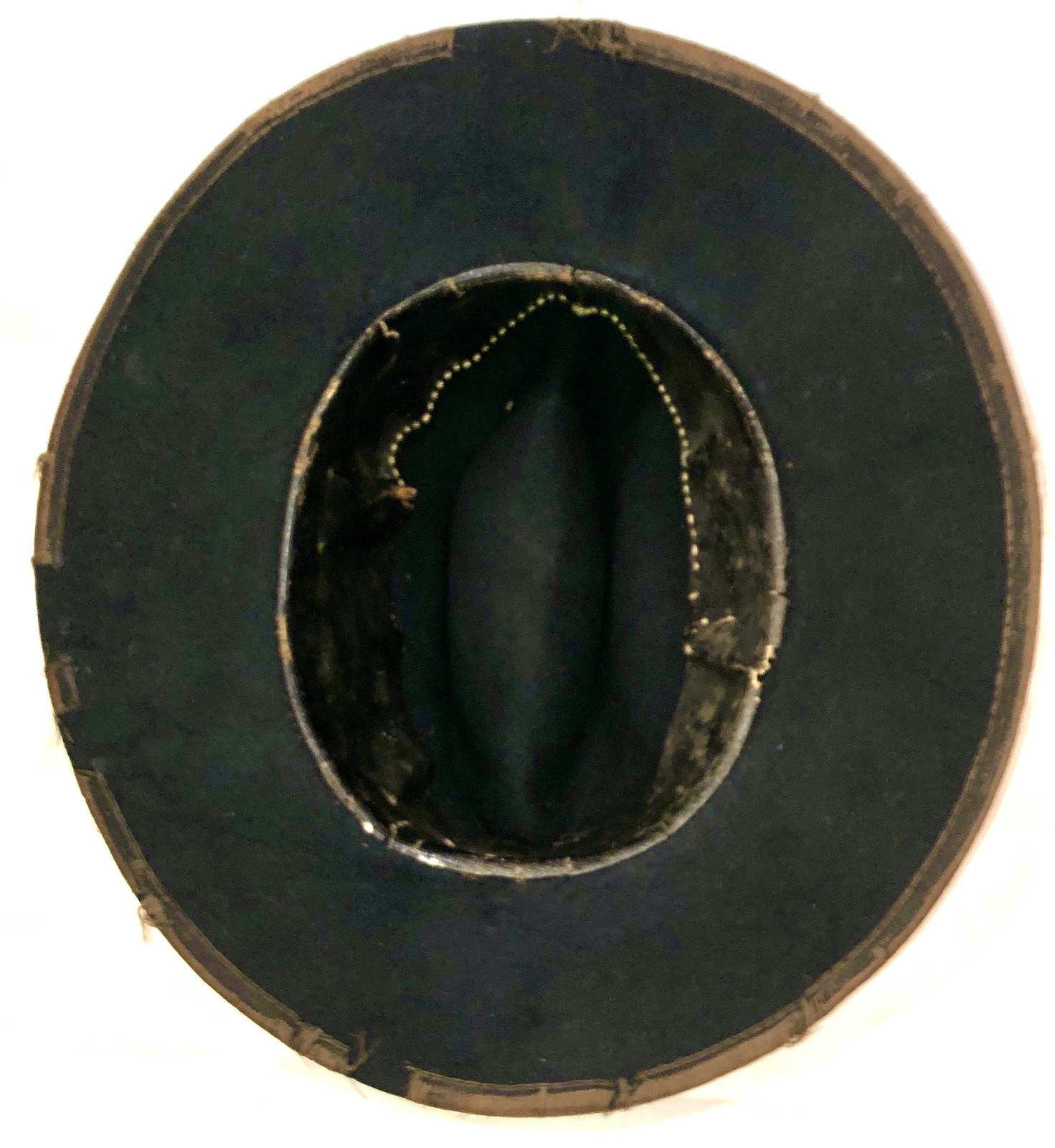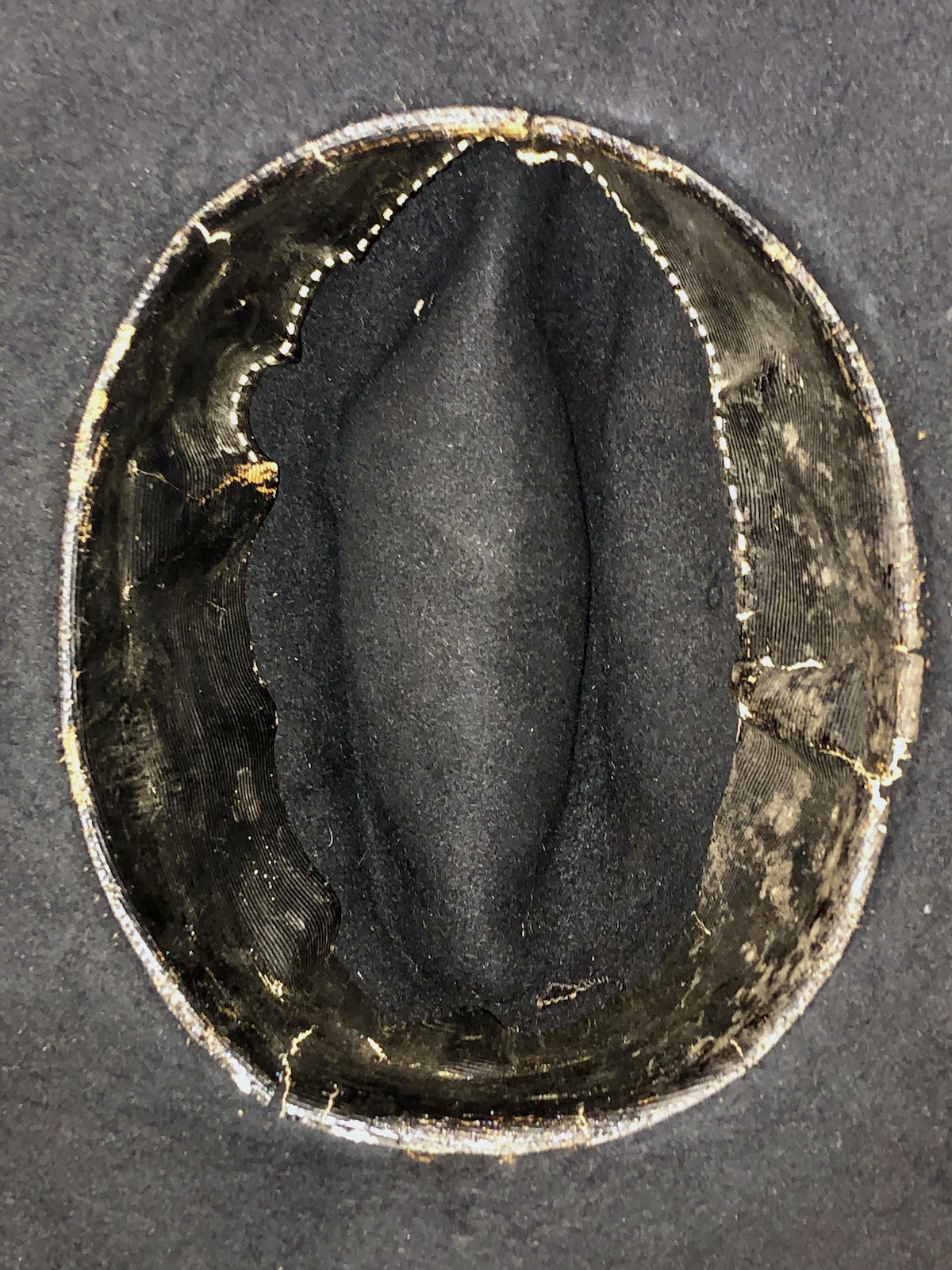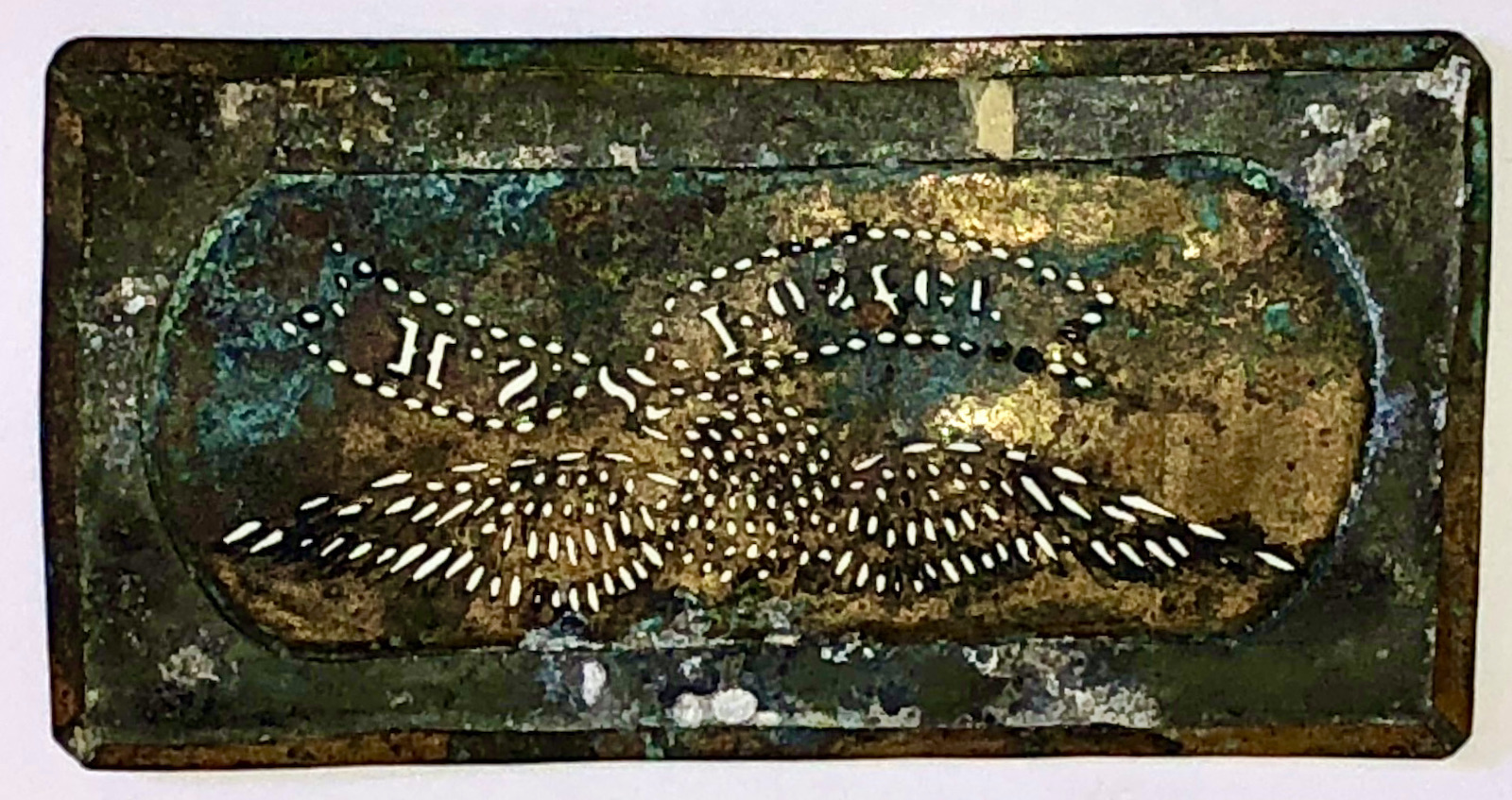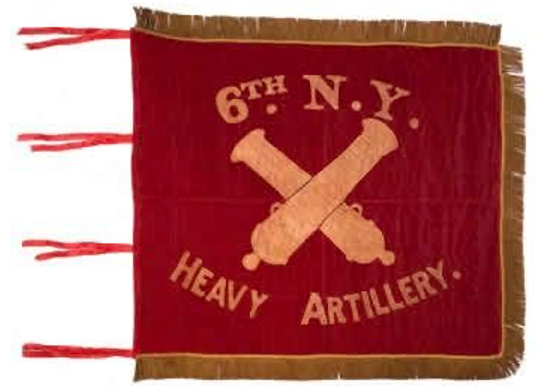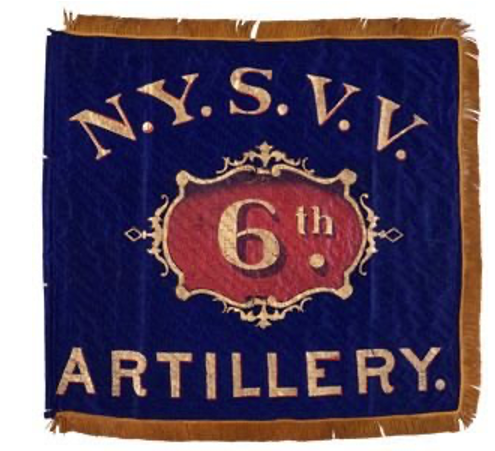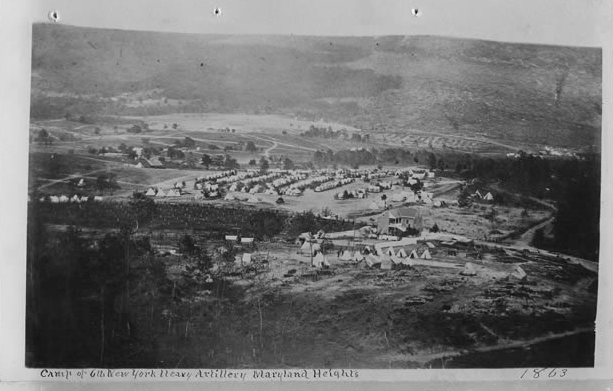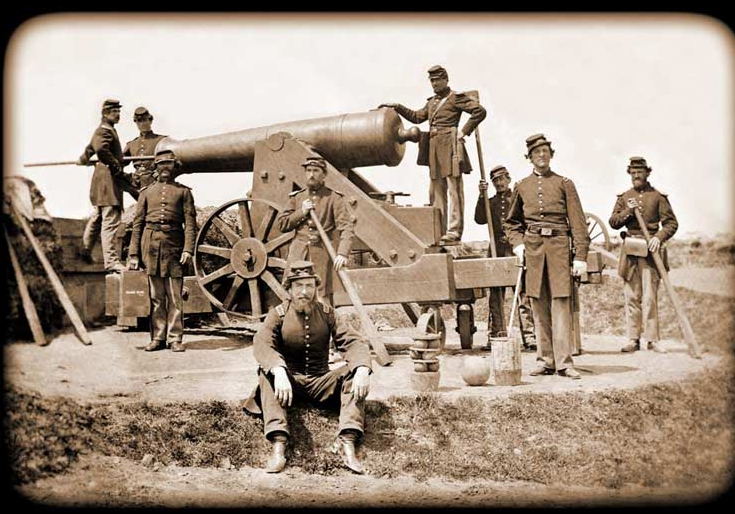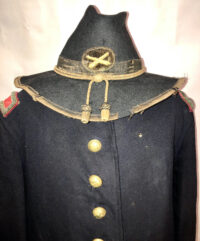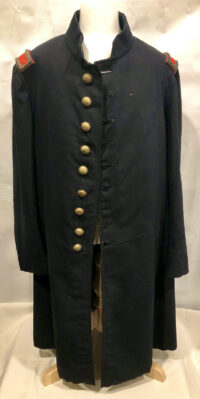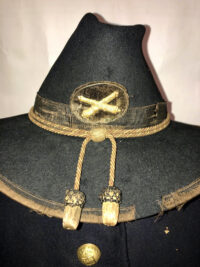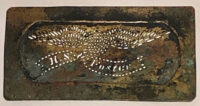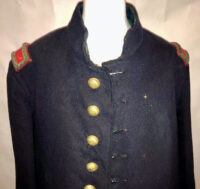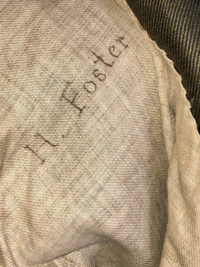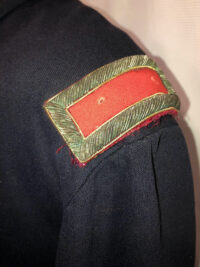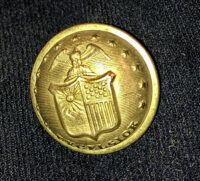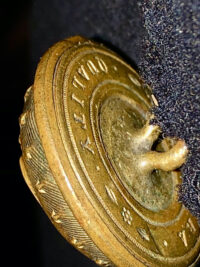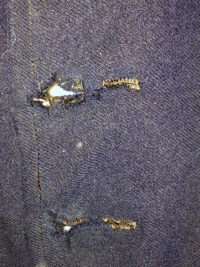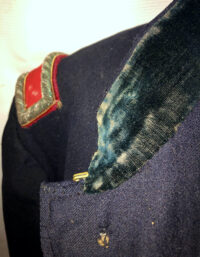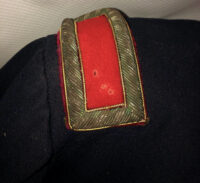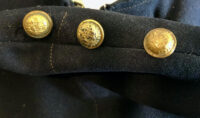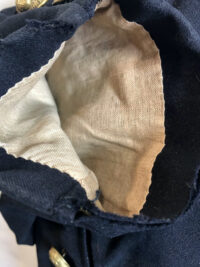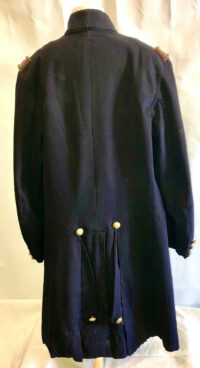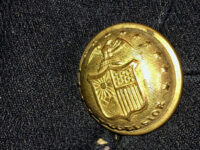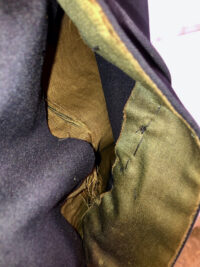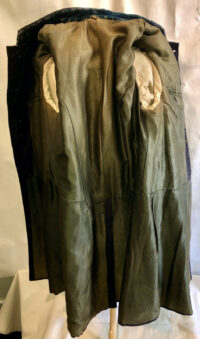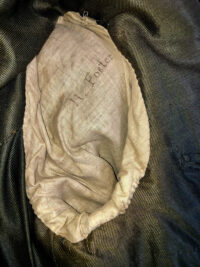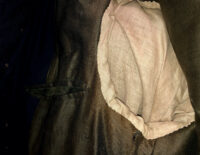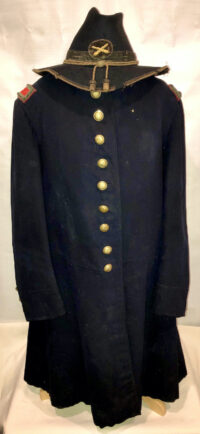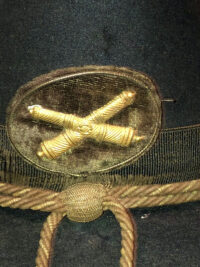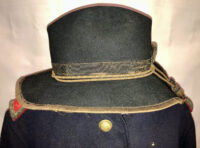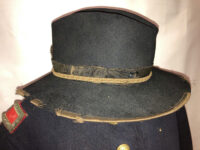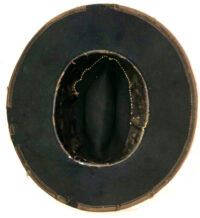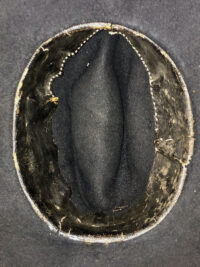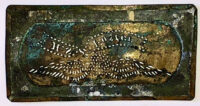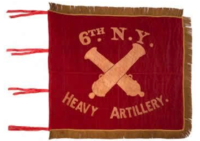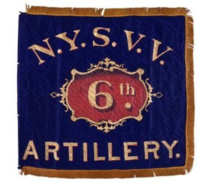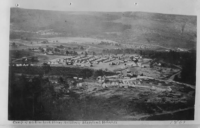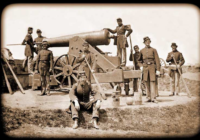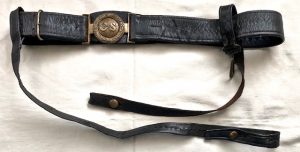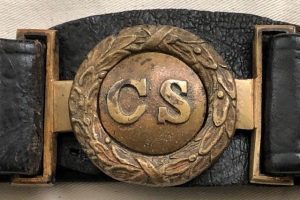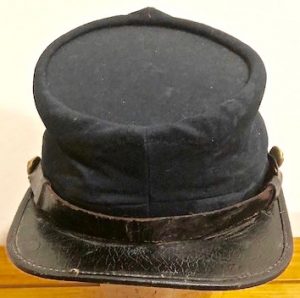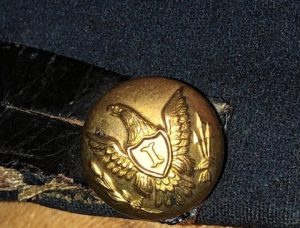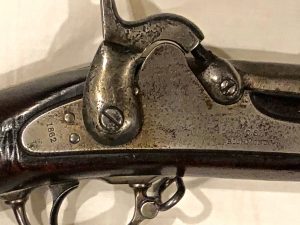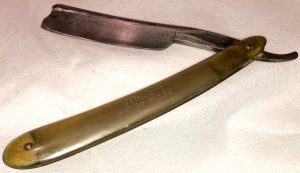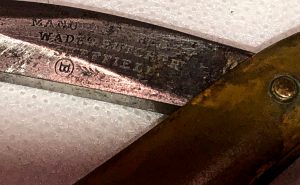Federal Officer’s Frock Coat, Slouch Hat and Stencil – Identified to 2nd Lt. Henry S. Foster, Co. M 6th New York Heavy Artillery
SOLD
Federal Officer’s Frock Coat, Slouch Hat and Stencil – Identified to 2nd Lt. Henry S. Foster, Co. M 6th New York Heavy Artillery – This impressive grouping is composed of Lt. Foster’s frock coat, slouch hat and his military stencil; in the right sleeve lining of the coat, just inside from the body, is hand inked the following:
“H. Foster”
Lt. Foster’s accompanying stencil reads as follows:
“H. S. Foster”
- Frock Coat: Typical Union line officer’s, Civil War, frock coat, that exhibits all of the following characteristics inherent in a period, military, frock coat: constructed of a fine, deep blue, indigo-dyed, broadcloth wool; length of long, unhemmed skirts comparable to the length or height of the torso section; high, upright collar; collar lined in a blue velvet; pockets lined in polished, brown cotton in each of the tails or skirts; nine button front and four button skirts (all New York staff buttons, Extra Quality back marked); three, non-functioning NY cuff buttons on each cuff; wide “balloon” elbow areas; quilted, green, satinet lining, with two inner large pockets and one small watch pocket; blue velvet lined interior of the collar; presence of buckram stiffener within elements of the coat’s interior; off-white linen sleeve linings; combination of hand and chain stitch machine sewing throughout; original, Civil War period, 2nd Lieutenant of the Artillery shoulder boards or rank straps
- Slouch Hat: Hat constructed of a fine quality beaver or rabbit felt, exhibiting the desired “mellow”, pliable feel to the touch; original, Civil War officer’s hat cord; black, grosgrain silk, ribbon binding around the brim; wide, black silk, grosgrain ribbon and flat bow, circumferentially around the exterior of the hat’s crown; wide, black leather sweatband; original faux bullion on velvet, artillery crossed cannon insignia affixed to the front of the hat
- Stencil: Small, Civil War period, jeweler cut, sheet brass stencil, with partial, sheet lead backing; Henry Foster’s name is clearly cut in the stencil, as well as a finely executed, spread wing, American eagle, above Foster’s name, indicative of his military service; measurements: L – 3”; W – 1.5”
Coat Condition: The coat remains in overall, very good condition; it exhibits some minor insect damage, as well as some seam openings and evidence of field wear; the tail pockets only have about half of the original, polished brown cotton linings; the sleeve and interior body linings are in excellent condition.
Hat Condition: The slouch hat is in very good condition, with most of the two sets of grosgrain, silk binding remaining; the ribbon is faded from field wear; the body of the hat is in very good condition, with no holes or tears; the very wide, black leather sweat band is in very good condition and is complete, with no tears.
Stencil Condition: The stencil remains in excellent condition; it exhibits some field tarnishing; all of the lettering and piercings composing the eagle are complete and not damaged.
Lt. Foster enlisted in the 6th NY Heavy Artillery in August of 1862 and would serve throughout the war, until he mustered out, at Petersburg, in June of 1865. During the course of his service, Foster was wounded at the Battle of Cedar Creek, on October 19,1864. He had just earned a commission as a 2nd Lt. on October 1, 1864, so this would have been his frock coat and slouch hat, at the time of his wounding. During his service in the 6th NY HA, Foster would participate, with his regiment, in the following engagements: Battle of the Wilderness, Battle of Spotsylvania Courthouse, Battle of Mine Run, Battle of Cold Harbor, Battle of Cedar Creek, the Siege of Petersburg.
Henry Foster
| Residence was not listed; 35 years old.
Enlisted on 8/25/1862 at Haverstraw, NY as a Private. On 12/4/1862 he transferred into “M” Co. NY 6th Heavy Artillery He was Mustered Out on 6/28/1865 at Petersburg, VA He was listed as: * Wounded 10/19/1864 Cedar Creek, VA Promotions: * Corpl 2/10/1863 * Sergt 3/15/1863 * 1st Sergt 12/1/1863 * 2nd Lieut 10/1/1864 (As of Co. I) Intra Regimental Company Transfers: * 1/26/1864 from company M to company A * 3/5/1865 from company A to company I
|
6th NY Heavy Artillery
( 3-years )
| Organized: Yonkers, NY on 10/6/62 Mustered Out: 8/24/65 at Washington, DCOfficers Killed or Mortally Wounded: 6 Officers Died of Disease, Accidents, etc.: 6 Enlisted Men Killed or Mortally Wounded: 130 Enlisted Men Died of Disease, Accidents, etc.: 275 (Source: Fox, Regimental Losses) |
| From | To | Brigade | Division | Corps | Army | Comment |
| Sep ’62 | Dec ’62 | Artillery | Defenses of Baltimore | 8 | Middle Department | |
| Jan ’63 | Mar ’63 | Artillery | Defenses Upper Potomac | 8 | Middle Department | |
| Mar ’63 | Jun ’63 | 2 | 1 | 8 | Middle Department | |
| Jun ’63 | Jul ’63 | 3rd Prov’l | French’s Command | 8 | Middle Department | |
| Jul ’63 | Aug ’63 | 1 | 3 | 3 | Army of Potomac | |
| Jul ’63 | Aug ’63 | Unatt Arty Res | Army of Potomac | |||
| Dec ’63 | Apr ’64 | Artillery | US Forces, Yorktown | 18 | Department of Virginia and North Carolina | 5 Cos. |
| Apr ’64 | May ’64 | 1st Vol Arty Res | Army of Potomac | |||
| May ’64 | Jun ’64 | Kitching’s | 5 | Army of Potomac | ||
| Jun ’64 | Jul ’64 | 3 | 2 | 5 | Army of Potomac | |
| Aug ’64 | Sep ’64 | 1 | Defenses North of Potomac | 22 | Department of Washington, D.C. | |
| Sep ’64 | Dec ’64 | 1 | Kitching’s Prov’l | Army of the Shenandoah | ||
| Dec ’64 | Apr ’65 | 2 | Infy Div. Defenses Berm. Hund. | 18 | Army of the James | |
| Mar ’65 | Apr ’65 | 2 | 1 | 10 | Department of North Carolina | 6 Cos. |
6th New York Heavy Artillery Regiment
The 6th Regiment New York Heavy Artillery, U.S. Volunteers, the “Anthony Wayne Guard”, was an artillery regiment of the Union Army during the American Civil War. It was originally mustered in as the 135th New York Volunteer Infantry Regiment, and served as both artillery and infantry.
Service
The regiment was organized under Col. William H. Morris and Lieut.-Col. J. Howard Kitching, at Yonkers, as the 135th Regiment of Infantry, and there mustered in the service of the United States for three years, September 2, 1862; having been converted into an artillery regiment, it was, October 6, 1862, designated the 6th Regiment of Artillery, and two additional companies were recruited for it and mustered, December 4, 1862, in the United States service for three years; Company M was consolidated into Company A, January 26, 1864, and a new company formed of the men recruited by M. R. Pierce, for the 14th Artillery, transferred to this regiment January 13, 1864; February 2, 1864, surplus men of the 14th and 16th Artillery, about 400, were also transferred to this regiment. June 28, 1865, the men whose term of service would expire October 1, 1865, were, under the command of Col. George C. Kibbe, mustered out at Petersburg, Virginia; those remaining were organized into a battalion of four companies, A, B, C and D; and there were added to them, July 19, 1865, the men not discharged at the muster-out of their regiments, of the 10th Artillery, forming Companies L, F and G, and of the 13th Artillery, forming Companies H, I, K, L and M, thus reorganizing the regiment.
The original companies were recruited principally:
- A and F at Peekskilland Yonkers;
- B at Greenburgh, White Plains, Scarsdale, Harrisonand Pleasant;
- C at West Farms;
- D at Somers, North Salem, Bedfordand Poundridge;
- E at Port Chester, New York, Harrison, New Rochelle, Mamaroneckand Rye;
- G at South East, Kentand Carmel;
- H at Morrisania;
- I at Ossining, New Castle, Yorktown, Cortland, Mt. Pleasant and Bedford;
- K at Orangetown, White Plains, West Farms, Clarkstown, Scarsdale and Greenburgh;
- L at Cold Springs, Carmel, Yorktown and Queensborough, at Patersonand town of Kent, New Jersey; and
- M at Haverstraw, Yonkers, Somers, Poundridge, Bedford, Mt. Pleasant, North Salem and New Castle.
The regiment (ten companies) left the State, September 5, 1862, and served in the Railroad Division of the 8th Corps, Middle Department, from September 1862; Companies L and M joined it at Baltimore, Maryland, in December 1862; the regiment served at Harper’s Ferry, West Virginia, defenses of the Upper Potomac River, from January 1863; in the 2d Brigade, 1st Division, 8th Corps, from March 27, 1863; in the 1st Brigade, 1st Division, 8th Corps, from June 1863; in the 1st Brigade, 3d Division, 3d Corps, Army of Potomac, from July 10, 1863; with the Reserve Artillery, Army of Potomac, as Ammunition Guard from August 1863; in the 1st Brigade, Reserve Artillery, Army of Potomac, from April 1864; in the Heavy Artillery Brigade, 5th Corps, from May 13, 1864; in the 3d Division, 5th Corps, from May 30, 1864; in the 3d Brigade, 2d Division, 5th Corps, from June 2, 1864; in the 1st Brigade, Harden’s Division, 22d Corps, from July 1864; in the 1st Brigade, Kitching’s Provisional Division, Army of the Shenandoah, from September 27, 1864; in the 2d Brigade, Ferrero’s Division, Army of the James, at Bermuda Hundred, Virginia, from December 1864. It served as heavy artillery and infantry.[1]
The 6th New York Heavy Artillery was at the crossroads of many of the Civil War’s fiercest battles. Their first action occurred in December 1862 in Maryland. They guarded the Baltimore and Ohio Railroad and occasionally skirmished with Confederate sympathizers. In the summer of 1863, they marched with the Army of the Potomac and served as part of the reserves at the Battle of Gettysburg. After the battle was over, members of the regiment buried the dead.[2]
When General Ulysses S. Grant launched his overland campaign in the spring of 1864, the 6th participated in a succession of bloody battles. These included the Battle of the Wilderness, the Battle of Spotsylvania, the Battle of Cold Harbor, the Siege at Petersburg, and the Battle of Cedar Creek, which was fought on October 19. At Cedar Creek, located in the Shenandoah Valley, the 6th were surprise attacked by the Confederates. They rallied and were able to repulse the attack thanks to the leadership of General Sheridan. Unfortunately for the 6th, Colonel J. Howard Kitching was wounded and died of his wounds on January 10.[3] They 6th also distinguished themselves at the Battle of Harris Farm. They held their ground for over two hours and repulsed a more experienced enemy. General Gordon Meade commended the regiment “for their gallantry conduct in this affair and classing us with the Veterans of the Army of the Potomac.”[4]
Total strength and casualties
The regiment was honorably discharged and mustered out August 24, 1865, near Washington, D. C., having during its service lost by death, killed in action, 1 officer, 62 enlisted men; of wounds received in action, 5 officers, 68 enlisted men; of disease and other causes, 6 officers, 278 enlisted men; total, 12 officers, 408 enlisted men; aggregate, 420; of whom 57 enlisted men died in the hands of the enemy.[5]
Commanders
- Colonel William H. Morris– promoted to Brigadier General
- Colonel Howard Kitching– mortally wounded
- Colonel George C. Kibbe
- Colonel Stephen D. Baker
New York
SIXTH REGIMENT OF ARTILLERY (HEAVY).
Anthony Wayne Guard.
(Three Years)
| Col. Lewis G. Morris, succeeded by Col. Wm. H. Morris,
received August 14, 1862, authority to recruit a regiment in the counties of Putnam, Rockland and Westchester. The regiment was organized under Col. W. H. Morris and Lieut.-Col. J. Howard Kitching, at Yonkers, as the 135th Regiment of Infantry, and there mustered in the service of the United States for three years, September 2, 1862; having been converted into an artillery regiment, it was, October 6, 1862, designated the 6th Regiment of Artillery, and two additional companies were recruited for it and mustered, December 4, 1862, in the United States service for three years; Company M was consolidated into Company A, January 26, 1864, and a new company formed of the men recruited by M. R. Pierce, for the 14th Artillery, transferred to this regiment January 13, 1864; February 2, 1864, surplus men of the 14th and 16th Artillery, about 400, were also transferred to this regiment. June 28, 1865, the men whose term of service would expire October 1, 1865, were, under the command of Col. George C. Kibbe, mustered out at Petersburg, Va.; those remaining were organized into a battalion of four companies, A, B, C and D; and there were added to them, July 19, 1865, the men not discharged at the muster-out of their regiments, of the 10th Artillery, forming Companies L, F and G, and of the 13th Artillery, forming Companies H, I, K, L and M, thus reorganizing the regiment.
The original companies were recruited principally: A and F at Peekskill and Yonkers; B at Greenburgh, White Plains, Scarsdale, Harrison and Mt. Pleasant; C at West Farms; D at Somers, North Salem, Bedford and Poundridge; E at Port Chester, Harrison, New Rochelle, Mamaroneck and Rye; G at South East, Kent and Carmel; H at Morrisania; I at Ossining, New Castle, Yorktown, Cortland, Mt. Pleasant and Bedford; K at Orangetown, White Plains, West Farms, Clarkstown, Scarsdale and Greenburgh; L at Cold Springs, Carmel, Yorktown and Greenborough, at Paterson and town of Kent, N. J.; and Company M at Haverstraw, Yonkers, Somers, Poundridge, Bedford, Mt. Pleasant, North Salem and New Castle. The regiment (ten companies) left the State, September 5, 1862, and served in the Railroad Division of the 8th Corps, Middle Department, from September, 1862; Companies L and M joined it at Baltimore, Md., in December, 1862; the regiment served at Harper’s Ferry, W. Va., defenses of the Upper Potomac, from January, 1863; in the 2d Brigade, 1st Division, 8th Corps, from March 27, 1863; in the 1st Brigade, 1st Division, 8th Corps, from June, 1863; in the 1st Brigade, 3d Division, 3d Corps, Army of Potomac, from July 10, 1863; with the Reserve Artillery, Army of Potomac, as Ammunition Guard from August, 1863; in the 1st Brigade, Reserve Artillery, Army of Potomac, from April, 1864; in the Heavy Artillery Brigade, 5th Corps, from May 13, 1864; in the 3d Division, 5th Corps, from May 30, 1864; in the 3d Brigade, 2d Division, 5th Corps, from June 2, 1864; in the 1st Brigade, Harden’s Division, 22d Corps, from July, 1864; in the 1st Brigade, Kitching’s Provisional Division, Army of the Shenandoah, from September 27, 1864; in the 2d Brigade, Ferrero’s Division, Army of the James, at Bermuda Hundred, Va., from December, 1864. It served as heavy artillery and infantry. Commanded by Col. Stephen Baker, the regiment was honorably discharged and mustered out August 24, 1865, near Washington, D. C.
|
6th Heavy Artillery Regiment
Nickname: Anthony Wayne Guard
Mustered in as the 135th regiment of infantry: September 2, 1862.
Designated 6th regiment of heavy artillery: October 3,1862.
Mustered out: August 24, 1865.
THE FOLLOWING IS TAKEN FROM NEW YORK IN THE WAR OF THE REBELLION, 3RD ED. FREDERICK PHISTERER. ALBANY: J. B. LYON COMPANY, 1912.
Col. Lewis G. Morris, succeeded by Col. Wm. H. Morris, received August 14, 1862, authority to recruit a regiment in the counties of Putnam, Rockland and Westchester. The regiment was organized under Col. W. H. Morris and Lieut.-Col. J. Howard Kitching, at Yonkers, as the 135th Regiment of Infantry, and there mustered in the service of the United States for three years, September 2, 1862; having been converted into an artillery regiment, it was, October 6, 1862, designated the 6th Regiment of Artillery, and two additional companies were recruited for it and mustered, December 4, 1862, in the United States service for three years; Company M was consolidated into Company A, January 26, 1864, and a new company formed of the men recruited by M. R. Pierce, for the 14th Artillery, transferred to this regiment January 13, 1864; February 2, 1864, surplus men of the I4th and 16th Artillery, about 400, were also transferred to this regiment. June 28, 1865, the men whose term of service would expire October I, 1865, were, under the command of Col. George C. Kibbe, mustered out at Petersburg, Va.; those remaining were organized into a battalion of four companies, A, B, C and D; and there were added to them, July 19, 1865, the men not discharged at the muster-out of their regiments, of the 10th Artillery, forming Companies L, F and G, and of the 13th Artillery, forming Companies H, I, K, L and M, thus reorganizing the regiment.
The original companies were recruited principally: A and F at Peekskill and Yonkers; B at Greenburgh, White Plains, Scarsdale, Harrison and Mt. Pleasant; C at West Farms; D at Somers, North Salem, Bedford and Poundridge; E at Port Chester, Harrison, New Rochelle, Mamaroneck and Rye; G at South East, Kent and Carmel; H at Morrisania; I at Ossining, New Castle, Yorktown, Cortland, Mt. Pleasant and Bedford; K at Orangetown, White Plains, West Farms, Clarkstown, Scarsdale and Greenburgh; L at Cold Springs, Carmel, Yorktown and Greenborough, at Paterson and town of Kent, N. J.; and Company M at Haverstraw, Yonkers, Somers, Poundridge, Bedford, Mt. Pleasant, North Salem and New Castle.
The regiment (ten companies) left the State, September 5, 1862, and served in the Railroad Division of the 8th Corps, Middle Department, from September, 1862; Companies L and M joined it at Baltimore, Md., in December, 1862; the regiment served at Harper’s Ferry, W. Va., defenses of the Upper Potomac, from January, 1863; in the 2d Brigade, 1st Division, 8th Corps, from March 27, 1863; in the 1st Brigade, 1st Division, 8th Corps, from June, 1863; in the 1st Brigade, 3d Division, 3d Corps, Army of Potomac, from July 10, 1863; with the Reserve Artillery, Army of Potomac, as Ammunition Guard from August, 1863; in the 1st Brigade, Reserve Artillery, Army of Potomac, from April, 1864; in the Heavy Artillery Brigade, 5th Corps, from May 13, 1864; in the 3d Division, 5th Corps, from May 30, 1864; in the 3d Brigade, 2d Division, 5th Corps, from June 2, 1864; in the 1st Brigade, Harden’s Division, 22d Corps, from July, 1864; in the 1st Brigade, Kitching’s Provisional Division, Army of the Shenandoah, from September 27, 1864; in the 2d Brigade, Ferrero’s Division, Army of the James, at Bermuda Hundred, Va., from December, 1864. It served as heavy artillery and infantry.
Commanded by Col. Stephen Baker, the regiment was honorably discharged and mustered out August 24, 1865, near Washington, D. C., having during its service lost by death, killed in action, 1 officer, 62 enlisted men; of wounds received in action, 5 officers, 68 enlisted men; of disease and other causes, 6 officers, 278 enlisted men; total, 12 officers, 408 enlisted men; aggregate, 420; of whom 57 enlisted men died in the hands of the enemy.
THE FOLLOWING IS TAKEN FROM THE UNION ARMY: A HISTORY OF MILITARY AFFAIRS IN THE LOYAL STATES, 1861-65 — RECORDS OF THE REGIMENTS IN THE UNION ARMY — CYCLOPEDIA OF BATTLES — MEMOIRS OF COMMANDERS AND SOLDIERS, VOLUME II: NEW YORK, MARYLAND, WEST VIRGINIA AND OHIO. MADISON, WI: FEDERAL PUB. CO., 1908.
Sixth Artillery (Heavy).—Cols., William H. Morris, J. Howard Kitching, George C. Kibbe, Stephen D. Baker; Lieut. -Cols., J. Howard Kitching, Ralph E. Prime, Edward R. Travis, Edward B. Williston, James B. Campbell, George C. Kibbe, Stephen D. Baker; Majs., J. H. Robinson, Edward R. Travis, Frederick Shonnard, James B. Campbell, Absalom A. Crookston, George C. Kibbe, Stephen D. Baker, Edmund Y. Morris, Ferd. R. Hassler, C. H. Palmer, Edward Jones. This regiment, known as the Anthony Wayne Guard, was recruited in the summer of 1862 in the counties of Putnam, Rockland and Westchester. It was organized at Yonkers as the 135th infantry and was there mustered into the U. S. service for three years, Sept. 2, 1862. It was converted into an artillery regiment in October and designated the 6th regiment of artillery, two additional companies recruited for it being mustered in on Dec. 4. After the consolidation of Co. M and Co. A in Jan., 1864, a new Co. M, composed of men recruited by M. R. Pierce for the 14th N. Y. artillery, was transferred to it, and in Feb., 1864, about 400 of the surplus men of the 14th and i6th artillery were also transferred to this regiment. On June 28, 1865, the men whose terms would expire on Oct. i, were mustered out at Petersburg, under command of Col. Kibbe, the veterans and recruits being formed into a battalion of four companies. On July 19, 1865, the remaining members of the loth and 13th artillery were transferred to this battalion, and this consolidated force was mustered out on Aug. 24, near Washington, D. C, under command of Col. Baker. The regiment— ten companies—left the state on Sept. 5, 1862, and Cos. L and M joined it at Baltimore in December. It served with the 8th corps at Harper’s Ferry and in the defenses of the Upper Potomac until July, 1863, when it was attached to the 1st brigade, 1st division, 3d corps, and in August, to the reserve artillery, Army of the Potomac, employed as ammunition guard. It took part in an action at Manassas gap in July, 1863, and in the Mine Run campaign in November. Then, as infantry and heavy artillery, it served until July, 1864, with the 5th corps. Army of the Potomac, being active in all the battles leading up to the investment of Petersburg, including the Wilderness, Spottsylvania, where its casualties amounted to 18 killed, 131 wounded and 6 missing, the North Anna, where it lost 17 killed, 99 wounded and 17 missing, Totopotomy, Cold Harbor, and the assault on Petersburg in June, with a loss of 92. In July it was attached to the 1st brigade, Hardin’s .division, 22nd corps, and in August was ordered to Washington for garrison duty, remaining there for five weeks, when it was ordered to join the Army of the Shenandoah, attached to the 1st brigade, Kitching’s provisional division, and later to the 2nd brigade, Ferrero’s division. Army of the James, at Bermuda Hundred. In the battle of Cedar creek it was heavily engaged, losing 94 killed, wounded and missing, both Col. Kitching and Maj. Jones being mortally wounded. It was present at the fall of Petersburg on April 2, 1865. The regiment lost by death during service 6 officers and 130 men killed and mortally wounded; 6 officers and 278 men died of disease, accident, in prison, etc., a total of 420.
6th Regiment, New York Heavy Artillery
OVERVIEW:
Organized at Yonkers, N. Y., as the 135th Regiment Infantry, and mustered in September 2, 1862. Designation changed October 3, 1862. Left State for Baltimore, Md., September 5, 1862. Attached to Defences of Baltimore, Md., 8th Army Corps, Middle Department, to January, 1863. Defences. Upper Potomac, to March, 1863. 2nd Brigade, 1st Division, 8th Army Corps, to June, 1863. 3rd Provisional Brigade, French’s Division, 8th Army Corps, to July, 1863. 1st Brigade, 3rd Division, 3rd Army Corps, to August, 1863. Artillery Reserve and Headquarters and ammunition train guard, Army of the Potomac, to April, 1864. 1st Brigade, Artillery Reserve, Army of the Potomac, to May 13, 1864. Kitching’s Heavy Artillery Brigade, 5th Army Corps, Army of the Potomac, to May 30, 1864. 1st Brigade, 3rd Division, 5th Army Corps, to June 2, 1864. 3rd Brigade, 2nd Division, 5th Army Corps, to August, 1864. 1st Brigade, Hardin’s Division, 22nd Army Corps, Dept. of Washington, to September, 1864. 1st Brigade, Kitching’s Provisional Division, Middle Military Division, September 27 to December 3, 1864. 2nd Brigade, Provisional Division, Army of the James, and 2nd Brigade, Infantry Division, Defences of Bermuda Hundred, Army of the James, to March 1865. 2nd Brigade, Ferrero’s Division, Dept. of Virginia, to May, 1865. Sub-District of Roanoke, District of the Nottaway, Dept. of Virginia, to August, 1865.
SERVICE:
Duty at Fort McHenry, Baltimore, Md., to December, 1862. Companies “B,” “E,” “F,” “I” “L” and “M”). Companies “A,” “C,” “D,” “G,” and “K” at Harper’s Ferry, W. Va., December, 1862. Duty on the Upper Potomac till July, 1863. Pursuit of Lee July. Wapping Heights, Va., July 23. Ammunition train guard for Army of the Potomac till April, 1864. Bristoe Campaign October 9-22, 1863. Advance to line of the Rappahannock November 7-8. Mine Run Campaign November 26-December 2. Rapidan Campaign May-June, 1864. Battles of the Wilderness May 5-7. Spottsylvania May 8-12. Spottsylvania Court House May 12-21. Harris Farm (or Fredericksburg Road) May 19. North Anna River May 23-26. On line of the Pamunkey May 26-28. Totopotomoy May 28-31. Cold Harbor June 1-12. Bethesda Church June 3. Before Petersburg June 16-18. Siege of Petersburg June 16-July 9. Ordered to Washington, D. C., and duty in the Defences of that city till September. Sheridan’s Shenandoah Valley Campaign September to December. Battle of Cedar Creek October 19. Duty in the Shenandoah Valley till December. Moved to Bermuda Hundred, Va., and duty in the Defences at that point till March, 1865. Fort Brady January 24, 1865. Appomattox Campaign March 28-April 9. Fall of Petersburg April 2. Duty in the Sub-District of Roanoke, District of the Nottaway, Dept. of Virginia, till June, and at Petersburg, Va., till August. Mustered out near Washington, D. C., August 24, 1865.
Regiment lost during service 5 Officers and 130 Enlisted men killed and mortally wounded and 6 Officers and 275 Enlisted men by disease. Total 417.
6th New York Independent Battery’s Civil War Newspaper Clippings
In the battles that have been fought since the last of May, the New-York Heavy Artillery have taken a conspicuous and honorable part. We copy from the New York Times the following:
WASHINGTON, Friday, June 3.
A dispatch from the Army of the Potomac, dated on Tuesday night, says:
” The day before, the Fifth Corps, advancing from Hawe’s Store toward Bethesda Church, drove the enemy about two miles. At sunset, while our men were engaged in digging rifle pits, Rhodes’s and Early’s divisions made an attack on Warren’s right flank, causing him to fall back from his first line. The enemy then advanced and charged the second line. Kitching’s brigade of heavy artillery was posted there and opened a heavy lire in conjunction with batteries on both flanks, which nearly demolished the rebel column of attack. The enemy fell back in terrible disorder, and left their dead and wounded behind them on the field.”
In this engagement Crawford’s and Kitching’s brigade lost perhaps 200 killed and wounded, and they have buried that number of the enemy’s dead, taken over a hundred prisoners, exclusive of over a hundred Rebel wounded left on the field.
And the following from the New York Herald, shows that the conflict was a terrible one and the result glorious:
” So hot was the fire that the house was burned, and all the outbuildings adjacent; but neither battery or men yielded their position. An idea of the severity of the contest at this point may be gathered from the fact that after the fight one hundred and thirty dead rebels were found in front of General Crawford’s headquarters. But all the batteries did well and so all the divisions. Colonel Kitching’s brigade of heavy artillery—as yet novices in the field—stood their ground with the resoluteness of veteran campaigners. The brigade alone captured eighty prisoners.
” General Warren came upon the ground at the close of the day, and was highly gratified at the result.
” Colonel Christian stated that he had been in all the battles in Virginia with the rebel army, but had never been near such a fire. Colonel Kitching’s brigade behaved with great credit during the advance. It lost heavily.”
In the recent fight, says the Free Press, in front of Richmond, two boys of Co. L., 6th Regiment, N. Y. Artillery, both from Philipstown, Putnam County, were cut off from the rest of their company, when they were overtaken by a Rebel Captain and five privates. The Captain drew his sword and ordered them to surrender as prisoners of war; at the same time the boys leveled their muskets at the Captain and ordered him to surrender, which he did, and his privates with him, and the boys marched them safely into our camp.
On the 3d of June, the brigade of Heavy Artillery of which Colonel Kitching is in command, took a rifle pit after three and a half hours’ hard fighting. In the engagement, the skin of the Colonel’s neck had been grazed by a Minnie ball, producing a slight wound and a terrible swelling. The sharp-shooter who performed the deed was taken prisoner. He boldly declared that he had seven fair shots at the Colonel, and if he could only have hit and killed him, he could have died happy.
The friends, neighbors and fellow-citizens of the New York Sixth Heavy Artillery may well be proud of the valiant deeds of their sons, brothers, and friends. Such acts of heroism as they have performed, such effectual service as they have rendered the Union, amply compensates for the care and expense incurred in placing them in the field. May their future history be as brilliant in glorious deeds as the past.
COUNTY AFFAIRS.
WESTCHESTER COUNTY.
The Sixth New York Artillery.
We copied from the Highland Democrat, last week an account of this regiment, which we understood was incorrect in some particulars. We, therefore give this week another notice of the regiment, from the Peekskill Messenger.
This Regiment was mastered into the U. S. service Sept. 2, 1862 as the 135th N. N. S. V., and in about a month it was changed to Heavy Artillery. Its officers were appointed by the Eighth Senatorial District War Committee, and were as follows: William H. Morris, Colonel; Ralph E. Prime, Lieut. Colonel, Edmond R. Travis, Major. The last mentioned, E. R. Travis, was Captain in the Forty-Eighth, N. Y. S. V., had been in the service a year or more, and was at Port Royal almost from the commencement of operations there until after the capture of Fort Pulaski.
Col. Morris took command at once after his appointment. He is a son of Gen. P. Morris, and at the time of his appointment, was on the Staff of Brig. Gen., now Major Gen. Peck. Col. Morris possessed all the elements of a good soldier and capable efficient officer. He was a good tactition, as is proved by the fact that he is author of a work on military tactics which has become very popular and considered the best work of the kind extant. Col. Morris was in command some six or eight months and during that time the regiment was made all that it could be by mere drill and discipline. At the end of this time he was promoted to the position of Brigadier General.
During most of the time that Morris was Colonel, J. Howard Kitching was acting as Lieut. Colonel, in place of Ralph E. Prime, who had been appointed to that position but had not yet reported for duty; being on duty as Captain in the Duryea Zouaves. Prime, soon after reporting, resigned, being nominated Brigadier-General and, upon the promotion of Col. Morris, Kitching was promoted to the Colonelcy, E. R. Travis to the position of Lieut. Colonel, and A. A. Crookston was made Senior Major.
This regiment, as thus officered, was connected with the Army of the Potomac in June 1863, and has participated in all the marches and hardships of that Army since that date.
During the last six montes Col. Kitching has been acting as Brig. Gen., and the Regiment has been under the command of Lieut Col. Travis and Maj. Crookston, who by their bravery, efficiency and gentlemanly deportment, have gained the confidence and affection of both officers and men.
This Regiment was actively engaged, for the first time, on the 19th of May last near Spotsylvania Court House. That day Ewell’s Corps of rebel veterans, in an attempt to get at our wagon trains, met the brigade to which the Sixth Artillery is attached, and so stubbornly did they hold their ground and so bravely and successfully did they fight that gen. Meade issued the following order:
HEADQUARTERS OF THE POTOMAC.
The Major-General Commanding desires to express his satisfaction with the good conduct of Tyler’s Division and kitching’s Brigade of Heavy Artillery in the affair of yesterday evening. The gallant manner in which these commands (the greater portion being for the firs time under fire) met and checked the persistent attack of a corps of the enemy, led by one of his ablest Generals, justified the Commanding General in this special commendation of troops who, henceforth will be relied upon as were the tried veterans of the Second and Fifth Corps at the same time engaged.
” By command of Maj. Gen. MEAD,
” [Signed] S. S. WILLIAMS, A. A. G.
” Brigadier-General TYLER.
” Commanding Division.”
This regiment has been several times engaged since, and in every instance exhibited metal of the most approved character. We hope soon to hear of the promotion of E. R. Travis to the Colonelcy, the duties of which he has for some time been discharging with so much credit; in which event A. A. Crookston would succeed to the Lieut. Colonelcy, a position for which he is well fitted. We hope to hear, too, of the speedy re-call of Capt. Bassett to his place at the head of his company, with the members and officers of which he is deservedly popular.


